Microsoft RH-6 Triple Band GSM Phone User Manual 3108 Dufu fcc 1 1
Microsoft Mobile Oy Triple Band GSM Phone 3108 Dufu fcc 1 1
Contents
- 1. Manual 1
- 2. Manual 2
Manual 2

Menu functions
43
English
Flip call handling
Opening or closing the flip cover
may or may not affect voice call
handling. You can set this by
yourself.
1. Press Menu, and select Settings,
Call settings, Flip call handling.
2. Three options are listed:
•None (default setting):
Opening or closing the flip
cover does not affect the
status of the voice call.
•Answer & end calls:
• Opening the flip cover
answers a voice call.
• Closing the flip cover
ends a voice call.
•Answer calls only:
• Opening the flip cover
answers a voice call.
• Closing the flip cover
does not end a voice call.
Automatic redial
Press Menu, and select Settings,
Call settings and Automatic redial.
Select On, and your phone will
make a maximum of ten attempts to
connect the call after an
unsuccessful call attempt
(Depending on the network
environment).
Speed dialling
Press Menu, and select Settings,
Call settings and Speed dialling.
Select On and the names and phone
numbers assigned to the speed
dialling keys, from to ,
can be dialled by pressing and
holding the corresponding number
key.
Call waiting
Press Menu, and select Settings,
Call settings and Call waiting.
Select Activate and the network will
notify you of an incoming call
while you have a call in progress
(network service). See ”Handle a
waiting call” on page 11.
Summary after call
Press Menu, and select Settings,
Call settings, and Summary after
call. Select On. After each call, the
phone briefly displays the
approximate duration and cost of
the call (network service).
Send my caller identity
Press Menu, and select Settings,
Call settings and Send my caller ID.
Select Ye s and your phone number
will be displayed to the person you
are calling (network service). Select
Set by network and the setting
agreed upon with your service
provider is used.
Line for outgoing calls
Line for outgoing calls is a network
service to select the phone line 1 or
2, that is, the subscriber number, for
making calls.
Press Menu, and select Settings,
Call settings and Line for outgoing
3108_Dufu_fcc_1.1.fm Page 43 Friday, October 24, 2003 2:20 AM

Menu functions
44
calls. If you select Line 2 and have
not subscribed to this network
service, you will not be able to
make calls. However, calls on both
lines can be answered regardless of
the selected line.
If supported by your SIM card, you
can prevent the line selection by
selecting the option Lock.
For more information on
availability, contact your network
operator or service provider.
Tip: In standby mode, you
can switch from one line to
the other by pressing and
holding .
Phone settings
Language settings
Press Menu, and select Settings,
Phone settings, Language settings
and Phone language. Select the
language for the display texts. If
Automatic is selected, the phone
selects the language according to
the information on the SIM card.
Press Menu, and select Settings,
Phone settings, Language settings
and Writing language. Select and
set the permanent writing language
you want to use when inputting or
editing text.
Automatic keyguard
Note: When Keyguard is
on, calls may be possible to
the emergency number
programmed into your
phone (e.g. 112, 911, or other
official emergency number). Key in
the emergency number and press
. The number is displayed only
after you have keyed in its last digit.
You can set the keypad of your
phone to lock automatically after a
period of time. When the phone is
in standby mode with no function in
use, and the set time is reached, the
keypad locks automatically to
prevent accidental phone calls.
Press Menu, and select Settings,
Phone settings and Automatic
keyguard.
• To activate the automatic
keyguard, select On. The phone
prompts Set delay: Input the
time and press OK. You can set
the time from 10 seconds up to
60 minutes.
• To deactivate the automatic
keyguard, select Off.
Refer also to ”Keypad lock
(Keyguard)” on page 8.
Recognition time-out
You can set the maximum time the
phone will wait for your next stroke
when writing with the stylus, before
the phone starts to recognise the
strokes you wrote on the touch pad.
3108_Dufu_fcc_1.1.fm Page 44 Friday, October 24, 2003 2:20 AM
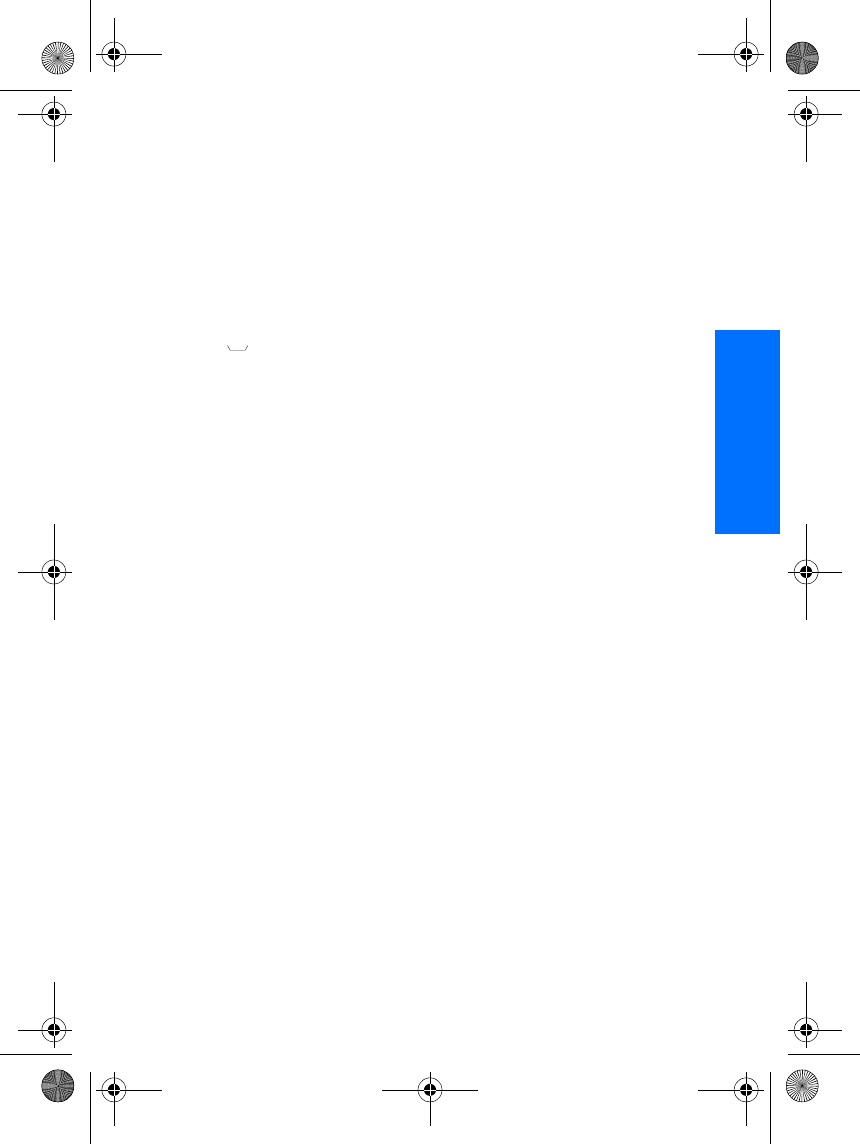
Menu functions
45
English
For more information about
recognition timeout, see also
“Recognition timeout” on page 17.
1. Press Menu, and select Settings,
Phone settings and Recognition
time-out.
2. A list of three options: Fast,
Normal and Slow is displayed:
3. Press if necessary to
highlight the option you want,
and press Select.
Cell info display (network
service)
Press Menu, and select Settings,
Phone settings and Cell info
display. Select On to set the phone
to indicate when it is used in a
cellular network based on Micro
Cellular Network (MCN)
technology.
If the GPRS connection is set to
Always online, the cell identity may
not be received. In that case, set the
GPRS connection to When needed
to enable it, see “GPRS
Connection” on page 60.
Welcome note
Press Menu, and select Settings,
Phone settings and Welcome note.
Enter the note you would like to be
shown briefly when the phone is
switched on. To save the note, press
Options, and select Save.
Network selection
Press Menu, and select Settings,
Phone settings and Operator
selection. Select Automatic and the
phone automatically selects one of
the cellular networks available in
your area.
If you select Manual, you can select
a network that has a roaming
agreement with your home network
operator. If No network access is
displayed, you must select another
network. The phone stays in manual
mode until the automatic mode is
selected or another SIM card is
inserted into the phone.
Confirm SIM service actions
See ”SIM services (Menu 13)” on
page 66.
Help text activation
To set the phone to show or not to
show the help texts, press Menu,
and select Settings, Phone settings
and Help text activation.
Start-up tone
To set the phone to play or not to
play a start-up tone when the phone
is switched on, press Menu, and
select Start-up tone, Phone settings
and Start-up tone.
Display settings
Wallpaper
You can set your phone to display a
background image, known as
3108_Dufu_fcc_1.1.fm Page 45 Friday, October 24, 2003 2:20 AM

Menu functions
46
wallpaper, when the phone is in
standby mode. Some images are
pre-saved in the Gallery menu. You
may also be able to receive images
via multimedia messages,
download them from WAP pages or
transfer them with PC Suite from
your compatible PC and then save
them in Gallery. Your phone offers
support to JPEG, GIF, BMP and
PNG formats. Please note ,
however, that not necessarily all
variations of these formats are
supoprted.
Select a wallpaper
1. Press Menu, and select Settings,
Display settings and Wallpaper.
2. Select Select wallpaper and the
folder list in the Gallery menu
will be shown.
3. Open the image folder and scroll
to the desired image.
4. To set the image as wallpaper,
press Options and select Set as
wallpaper.
To activate or deactivate the
wallpaper
Press Menu, and select Settings,
Display settings and Wallpaper. To
activate/deactivate the wallpaper,
select On/Off, respectively.
Colour schemes
You can change the colour in some
display components, for example,
indicators and signal bars.
Press Menu, and select Settings,
Display settings and Colour
schemes. Select the desired colour
scheme.
Operator logo
To set your phone to display or hide
the operator logo, press Menu, and
select Settings, Display settings and
Operator logo. If you have not
saved any operator logo, this menu
is dimmed.
Note that the operator logo is not
displayed when the phone activates
the screen saver.
For more information on
availability of an operator logo via
test messages, MMS or WAP,
contact your network operator or
service provider. See also ”PC
Suite” on page 68.
Display brightness
You can change the display
brightness level used on the phone
display.
Press Menu, and select Settings,
Display settings and Display
brightness. Scroll with and to
decrease and increase the
brightness level, and press OK to
accept it.
Tone settings
Press Menu, and select Settings and
then Tone settings. You can find the
same settings in the Profiles menu,
see ”Profiles (Menu 4)” on page 40.
3108_Dufu_fcc_1.1.fm Page 46 Friday, October 24, 2003 2:20 AM

Menu functions
47
English
Note that the settings you make,
will change the settings in the active
profile.
Select Incoming call alert to choose
how the phone notifies you of an
incoming voice call. The options
are Ringing, Ascending, Ring once,
Beep once and Off.
Select Ringing tone for incoming
voice calls. To select ringing tones
that have been saved in the Gallery,
select Open gallery from the
ringing tone list.
Select Ringing volume and
Vibrating alert for incoming voice
calls and messages. The vibrating
alert does not work when the phone
is connected to a charger.
Tip: If you receive a ringing
tone by downloading, you
can save the ringing tone in
the Gallery.
Select Message alert tone to set the
alert tone for the incoming
messages, Keypad tones, or
Warning tones to set the phone to
sound tones for example, when the
battery is running out of power.
Select Alert for to set the phone to
ring only upon calls from phone
numbers that belong to a selected
caller group. Scroll to the caller
group you want or All calls and
press Mark.
Enhancement settings
The enhancement settings menu is
shown only if the phone is or has
been connected to a compatible
enhancement.
Press Menu, and select Settings and
Enhancement settings. You can
select Headset, Handsfree,or
Loopset, if a corresponding
compatible enhancement is or has
been connected to the phone.
•Select Default profile to select
the profile that you want to be
automatically activated when
you connect to the selected
enhancement. You can select
another profile while the
enhancement is connected.
•Select Automatic answer to set
the phone to answer an
incoming call automatically
after five seconds. If the
Incoming call alert is set to Beep
once or Off, automatic answer
will not be in use.
•Select Lights to set the lights
permanently On. Select
Automatic to set the lights on for
15 seconds after a keypress. The
Lights option is available only
when Handsfree is selected.
Security settings
Note: When security
features that restrict calls
are in use (call barring,
3108_Dufu_fcc_1.1.fm Page 47 Friday, October 24, 2003 2:20 AM

Menu functions
48
closed user group and fixed
dialling), calls may be possible to
certain emergency numbers in some
networks (e.g. 112, 911, or other
official emergency numbers).
Press Menu, and select Settings and
Security settings. Select
•PIN code request to set the
phone to ask for your PIN code
every time the phone is switched
on. Some SIM cards do not
allow the PIN code request to be
turned off.
•Call barring service (network
service) to restrict incoming
calls to and outgoing calls from
your phone. A barring password
is required.
•Fixed dialling to restrict your
outgoing calls and text messages
to selected phone numbers if this
function is supported by your
SIM card. The PIN2 code is
required.
When the fixed dialling is on,
GPRS connections are not
possible except while sending
text messages over a GPRS
connection (network service). In
this case, the recipient’s phone
number and the message centre
number have to be included on
the fixed dialling list.
•Closed user group. Closed user
group is a network service that
specifies the group of people
whom you can call and who can
call you. For more information
contact your network operator or
service provider.
•Security level.
• If you select Phone, then the
phone asks for the Security
code when a new SIM card is
used.
• If you select Memory, then
the phone asks for the
Security code when memory
in use is going to be changed
from SIM card to others, (see
”Phone book settings” on
page 36), or entries in the
memory in use will be copied
to another memory (”Copy in
phone book” on page 38).
•Access codes to change the
security code, PIN code, PIN2
code or barring password. Codes
can only include numbers from
0 to 9.
Restore factory settings
To reset some of the menu settings
to their original values, press Menu,
and select Settings and Restore
factory settings. Key in the security
code and press OK.
■Alarm clock
(Menu 6)
The alarm clock uses
the time format set for the clock.
Even when the phone is switched
3108_Dufu_fcc_1.1.fm Page 48 Friday, October 24, 2003 2:20 AM
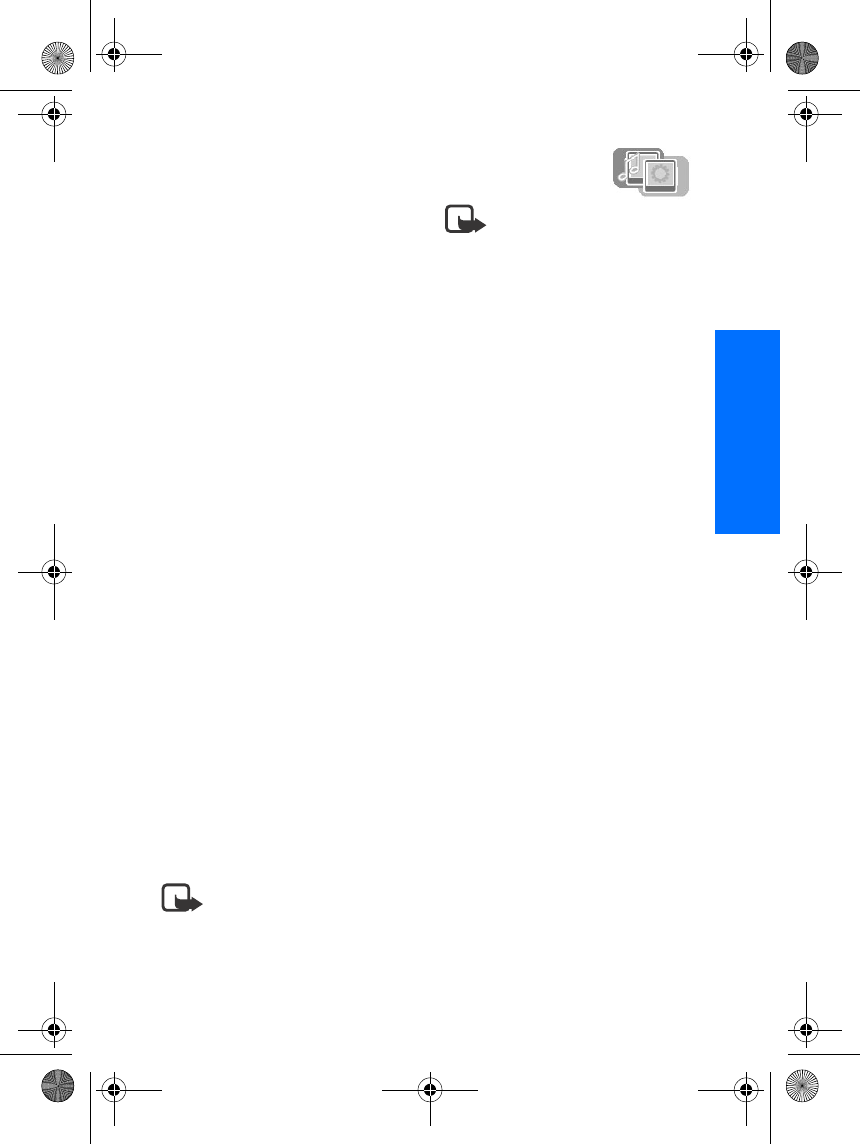
Menu functions
49
English
off, the previouly set alarm will still
work providing that there is enough
power in the battery.
Press Menu, and select Alarm
clock.
• Select Alarm time, enter the
alarm time and press OK.
To change the alarm time, select
On.
• Select Alarm tone and select the
default alarm tone.
When the alarm time
expires
The phone will sound an alert tone,
and flash Alarm! and the current
time on the display.
Press Stop to stop the alarm. If you
let the phone continue to sound the
alarm for a minute or press Snooze,
the alarm stops for about ten
minutes and then resumes.
If the alarm time is reached while
the phone is switched off, the phone
switches itself on and starts
sounding the alarm tone. If you
press Stop, the phone asks whether
you want to activate the phone for
calls, Switch the phone on?. Press
No to switch off the phone or Yes to
make and receive calls.
Note: Do not press Yes
when wireless phone use is
prohibited or when it may
cause interference or danger.
■Gallery
(Menu 7)
Note: Your
phone must be switched on
to use this function. Do not
switch the phone on when wireless
phone use is prohibited or when it
may cause interference or danger.
In Gallery you can manage images,
photos and tones saved in your
phone.
The gallery uses shared memory,
see ”Shared memory” on page 0.
1. Press Menu and select Gallery.
The list of options is shown.
2. Select View folders to open the
list of folders.
Other available options are:
•Add folder to add a new
folder. Key in a name for the
folder and press OK.
•Delete folder to select the
folder you want to delete.
You cannot delete the
original folders on the phone.
•Rename folder to select the
folder you want to rename.
You cannot rename the
original folders on the phone.
•Gallery downloads to
download more images and
tones. Select Graphic
downloads or Tone
downloads, respectively. The
list of available browser
3108_Dufu_fcc_1.1.fm Page 49 Friday, October 24, 2003 2:20 AM

Menu functions
50
bookmarks is shown. Select
More bookmarks to access
the list of bookmarks in the
Services menu, see
”Bookmarks” on page 62.
Select the appropriate
bookmark to connect to the
desired page. If the
connection fails, you may not
be able to access the page
from the service whose
connection settings are
currently active. In this case,
enter the Services menu and
activate another set of service
settings, see ”Making a
connection to a service” on
page 60. Try again to connect
to the page.
For the availability of
different services, pricing
and tariffs, contact your
network operator and/or
service provider. Download
content only from the sources
you trust.
3. Open the folder you want and
the list of files in the folder is
shown. Graphics and Tones are
the original folders in the phone.
Press Options and some of the
following options are available:
•Open to open the selected
file.
•Delete to delete the selected
file.
•Send to send the selected file
to compatible devices, via
MMS.
•Move to move a file to
another folder.
•Rename to give a new name
to the file.
•Set as wallpaper to set the
selected image file as
wallpaper.
•Set as ring tone to set the
selected sound file as the
ringing tone.
•Details to see the details of
the file, for example the size
of the file.
•Sort to sort the files by date,
type, name or size.
•Delete all to delete all the
files in the selected folder.
•Edit image to insert text, a
frame or clip-art to the
selected picture.
•View in sequence to view the
files in the folder
sequentially.
4. Open the file you want. Press
Options and some of the
following options may be
available:
•Play to listen to or to view a
sound or image file. file t.
•Zoom to increase the size of
the image that is contained in
the message.
3108_Dufu_fcc_1.1.fm Page 50 Friday, October 24, 2003 2:20 AM
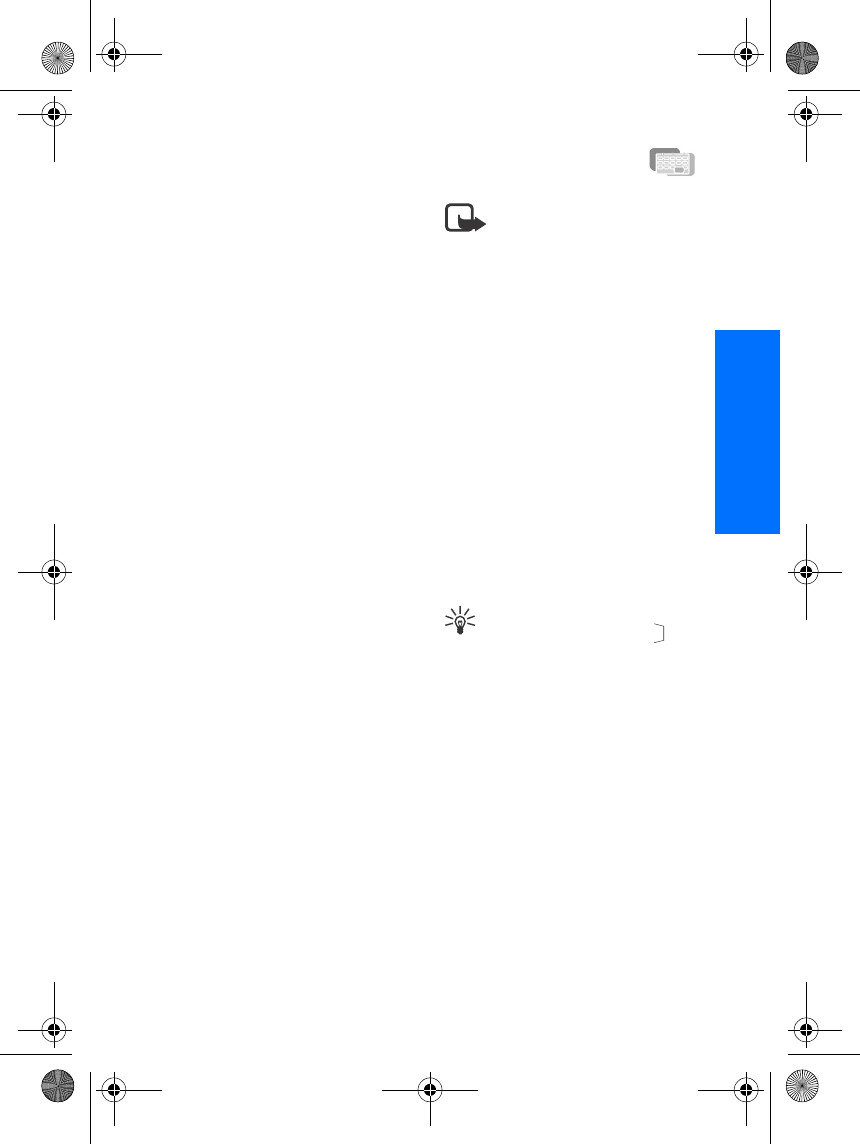
Menu functions
51
English
•Mute audio (Unmute audio)
to mute (unmute) the sound
file.
•Set contrast to adjust the
contrast level of the image.
•Set as wallpaper to set the
selected image file as
wallpaper.
•Set as ring tone to set the
selected sound file as the
ringing tone.
•Edit image to insert text, a
frame or clip-art to the
selected picture.
•Details to see the details of
the file, for example the size
of the file.
•Delete to delete the selected
file.
•Send to send the selected file,
for example, via MMS.
•Rename to give a new name
to the file.
•View in sequence to view the
files in the folder
sequentially.
Note that copyright protections may
prevent some images, ringing tones
and other content from being
copied, modified, transferred or
forwarded.
■Calendar (Menu
8)
Note: Your phone must be
switched on to use the
functions in the Calendar
menu. Do not switch the
phone on when wireless phone use
is prohibited or when it may cause
interference or danger.
Calendar
The calendar helps you to keep
track of reminders, calls that you
need to make, meetings, and
birthdays.
The calendar uses shared memory.
Refer to ”Shared memory” on page
0.
Press Menu, and select Calendar.
Tip: To quickly open the
Calendar menu, press in
standby mode.
Scroll to the day you want. The
current day is indicated by a frame
around the day. If there are any
notes set for the day, the day is in
bold type. To view the day notes,
press Options and select Day notes.
To view a single note, scroll to the
note you want to view, press
Options and select View. The note
view allows you to view the details
of the selected note. You can scroll
through the note.
3108_Dufu_fcc_1.1.fm Page 51 Friday, October 24, 2003 2:20 AM
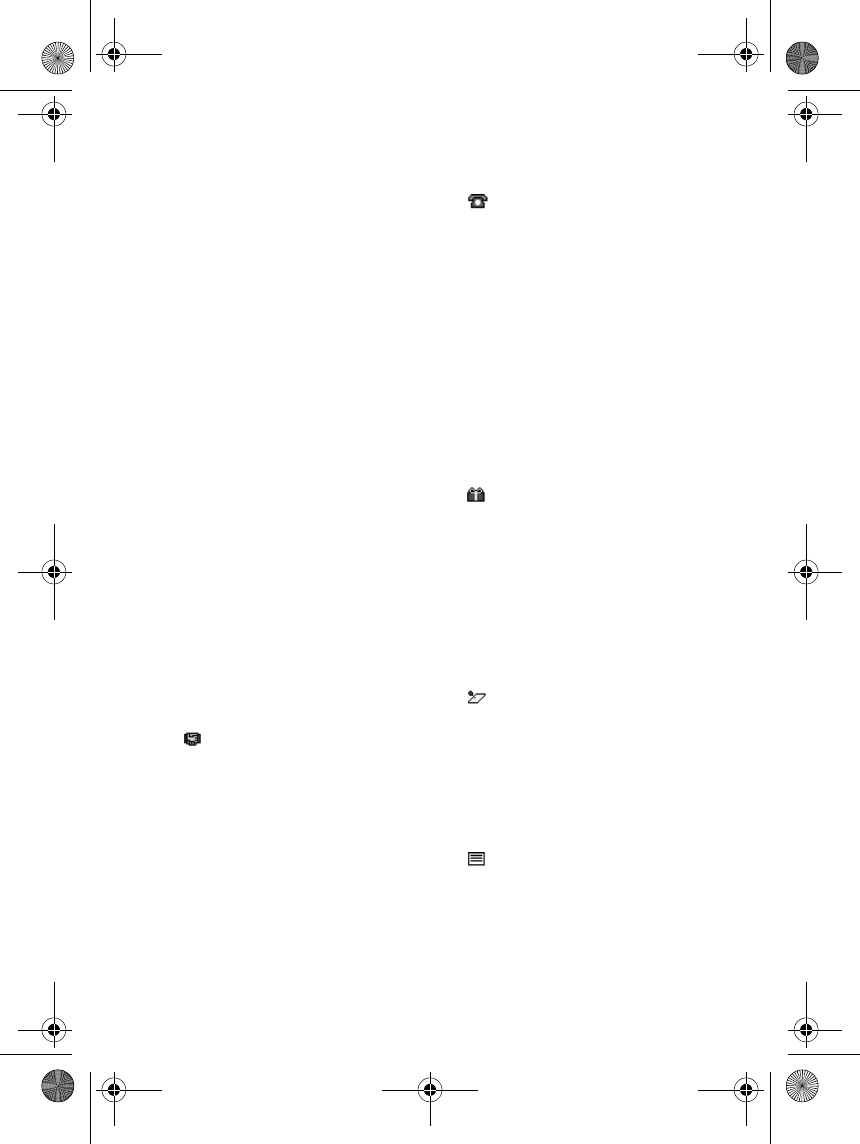
Menu functions
52
The other options for the
calendar views may include:
• Options for making a note, or for
sending a note as a note directly
to another compatible device’s
calendar or as a text message.
• Options for deleting, editing,
moving and repeating a note and
for copying a note to another
day.
•Settings to set the date, time,
date or time format, or the first
day of the week. In the Auto-
delete option you can set the
phone to delete old notes
automatically after a specified
time. However, the repeat notes,
for example, birthday notes, will
not be deleted.
Making a calendar note
Press Menu, and select Calendar.
Scroll to the date you want, press
Options and select Make a note.
Select one of the following note
types:
• Meeting - Enter the note (or
press Options and search for the
name in the phone book). Press
Options and select Save. Enter
the location for the meeting and
press Options and select Save.
Enter the start time for the
meeting and press OK, and then
the end time and press OK. To
set the alarm for the note, select
With tone or Silent (no alarm
tone) and then set the alarm
time.
• Call - Enter the phone
number, press Options and
select Save. Enter the name,
press Options and select Save.
(Instead of entering the phone
number, press Options to search
for the name and number in the
phone book.) Then enter the
time for the call and press OK.
To set the alarm for the note,
select With tone or Silent (no
alarm tone) and then set the
alarm time.
• Birthday - Enter the person’s
name (or press Options and
search for it in the phone book),
press Options and select Save.
Then enter the year of birth, and
press OK. To set the alarm for
the note, select With tone or
Silent (no alarm tone) and then
set the alarm time.
• Memo - Enter the note, press
Options and select Save. Enter
the end day for the note and
press OK. To set the alarm for
the note, select With tone or
Silent (no alarm tone) and then
set the alarm time.
• Reminder - Enter the subject
for the reminder, press Options
and select Save. To set the alarm
for the note, select Alarm on and
then set the alarm time.
3108_Dufu_fcc_1.1.fm Page 52 Friday, October 24, 2003 2:20 AM
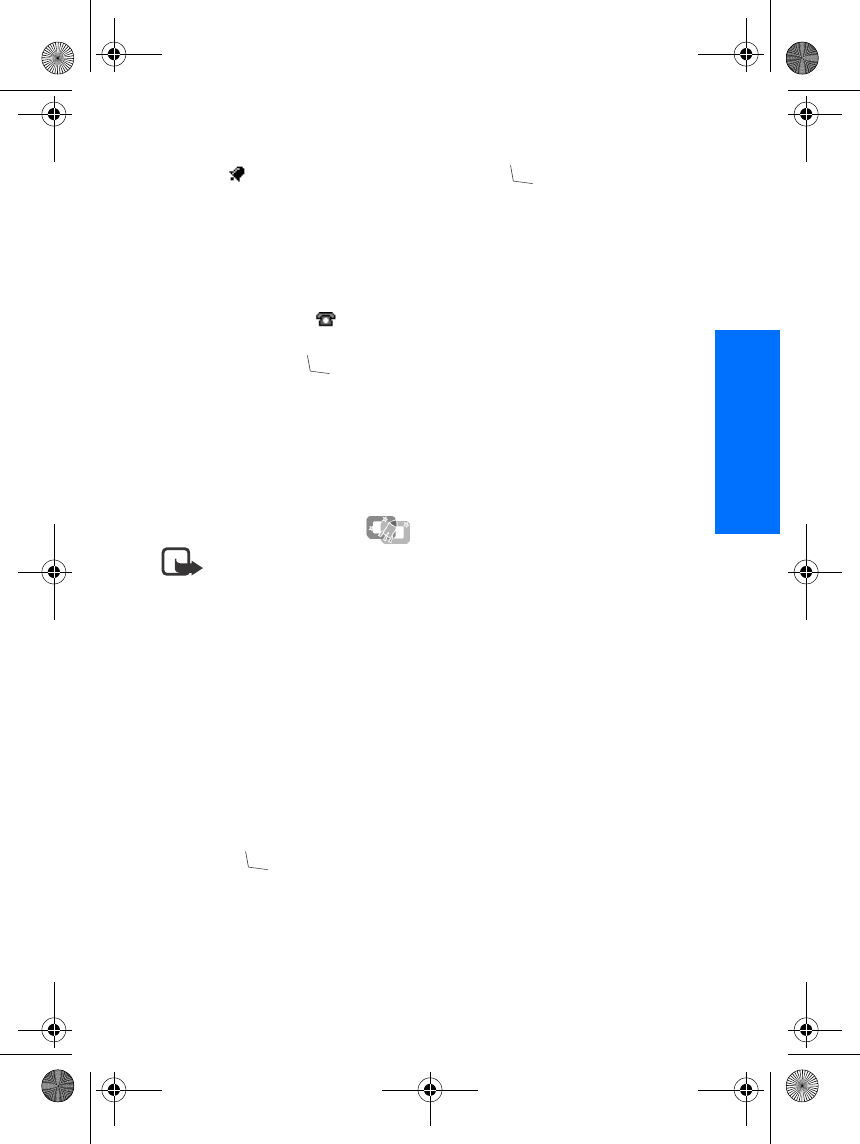
Menu functions
53
English
When you have set the alarm, the
indicator is displayed when the
alarm time is reached and you view
the notes.
When the phone sounds an
alarm for a note
The phone beeps, and displays the
note. With a call note on the
display, you can call the displayed
number by pressing . To stop
the alarm and view the note, press
View. To stop the alarm without
viewing the note, press Exit. Note
the alarm you set here will not work
when the phone is switched off.
■Games (Menu 9)
Note: Your phone
must be switched on to use
this function. Do not switch
the phone on when wireless phone
use is prohibited or when it may
cause interference or danger.
Launching a game
1. Press Menu, and select Games
and Select game.
2. Scroll to a game or a game set
(the name depends on the game).
3. Press Options and select Open
or press . If the selection is a
single game it will be launched.
Otherwise, a list of games in the
selected game set is displayed.
To launch a single game, scroll
to the desired game and press
Options and select Open, or
press .
Note that running some games
may consume the phone’s
battery faster (and you may need
to connect the phone to the
charger).
Other options available for a
game or game set
Options for games, see ”Other
options available for an application
or application set” on page 55.
Game services
Press Menu, and select Games and
Game downloads. The list of
available WAP bookmarks is
shown. Select More bookmarks to
access the list of WAP bookmarks
in the Services menu, see
”Bookmarks” on page 62.
Note that your phone may have
some pre-installed bookmarks for
sites not affiliated to Nokia. Nokia
does not warrant or endorse these
sites. If you choose to access them,
you should take the same
precautions, for security or content,
as you would with any Internet site.
Select the appropriate bookmark to
connect to the desired WAP page. If
the connection fails, you may not be
able to access the WAP page from
the WAP service whose connection
settings are currently active. In this
case, enter the Services menu and
activate another set of service
3108_Dufu_fcc_1.1.fm Page 53 Friday, October 24, 2003 2:20 AM

Menu functions
54
settings, see ”Making a connection
to a service” on page 60. Try again
to connect to the WAP page.
For the availability of different
WAP services, pricing and tariffs,
contact your network operator and/
or the WAP service provider.
Note that when downloading a
game, it may be saved in the
Applications menu instead of the
Games menu.
Note that after you have
downloaded a game, the WAP
connection is still on. You need to
end the connection before
launching the game, otherwise you
may be charged for the connection.
Memory status for games
To view the amount of memory
available for game and application
installations, press Menu, and select
Games and Memory. See also
”Memory status for applications”
on page 56.
The games use shared memory.
Refer to ”Shared memory” on page
0.
Game settings
Press Menu, and select Games and
Settings to set sounds, lights and
shakes for the game.
■Applications
(Menu 10)
Note: The phone must be
switched on to use this
function. Do not switch
on the phone when the use of a
wireless phone is prohibited or
when it may cause interference or
danger.
Note that after you have
downloaded an application, the
WAP connection is still on. You
need to end the connection before
launching the application,
otherwise you may be charged for
the connection.
Launching an application
1. Press Menu, and select
Applications and Select
application.
2. Scroll to an application or an
application set (the name
depends on the application).
3. Press Options and select Open
or press . If the selection is a
single application it will be
launched.
Otherwise, a list of applications
in the selected application set is
displayed. To launch a single
application, scroll to the desired
application and press Options
and select Open, or press .
Note that running some
applications may consume the
3108_Dufu_fcc_1.1.fm Page 54 Friday, October 24, 2003 2:20 AM
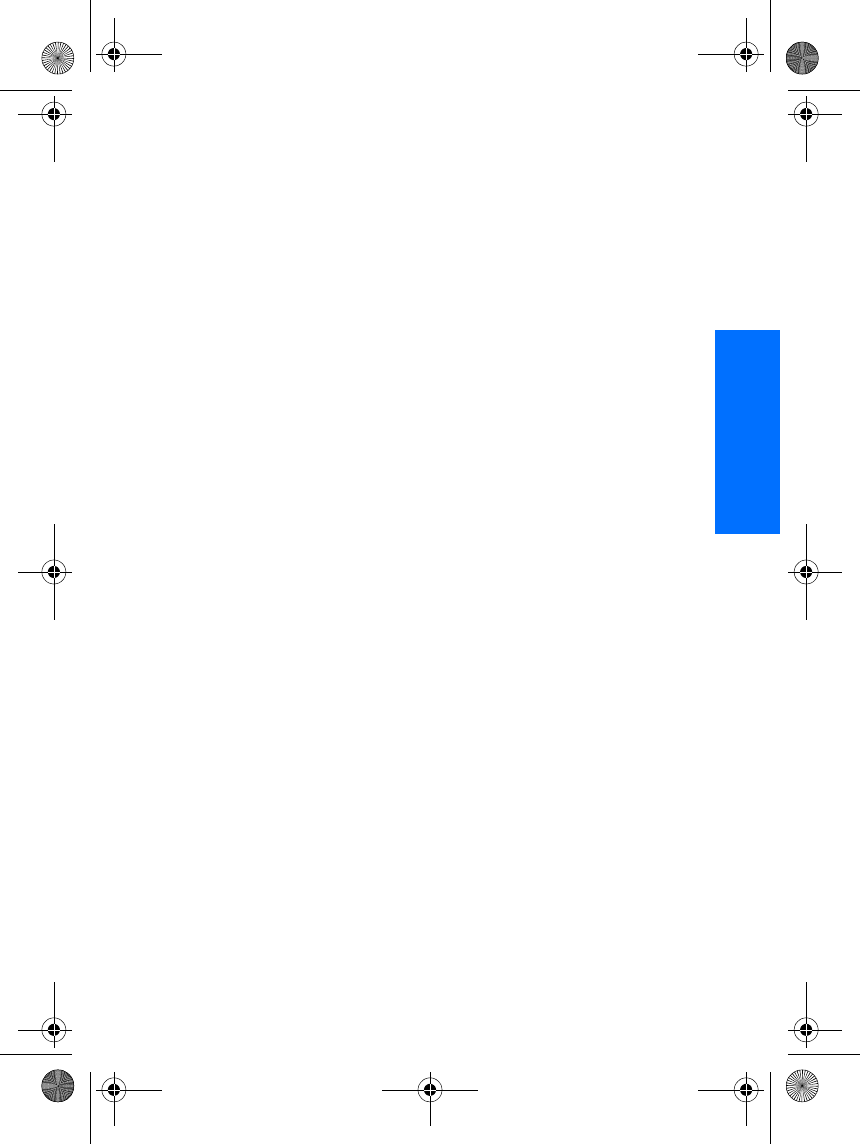
Menu functions
55
English
phone’s battery faster (and you
may need to connect the phone
to the charger).
Other options available for
an application or
application set
•Delete to delete the application
or application set from the
phone.
Note that if you delete a pre-
installed application or an
application set from your phone,
you may be able to download it
again to your phone from the
Nokia Software Market, http://
www.softwaremarket.nokia.co
m/wap. Note the availability
may vary in different markets.
•Web access to restrict the
application from accessing the
network. Select Ask first and the
phone asks for net access,
Allowed to allow the net access,
or Not allowed not to allow the
net access.
•Update version to check if a new
version of the application is
available for download from the
WAP servi c e s .
•Web page to provide further
information or additional data
for the application from an
Internet page. This feature needs
to be supported by the network.
It is only shown if an Internet
address has been provided with
the application.
•Connect via to choose and
activate a connection setting for
the application.
•Details to give additional
information about the
application.
Download an application
You can download new JavaTM
applications in different ways.
Please note that your phone only
support J2ME applications.
• Press Menu, and select
Applications and App.
downloads and the list of
available WAP bookmarks is
shown. Select More bookmarks
to access the list of WAP
bookmarks in the Services
menu, see ”Bookmarks” on page
62.
Select the appropriate bookmark
to connect to the desired WAP
page. If the connection fails, you
may not be able to access the
WAP page from the WAP
service whose connection
settings are currently active. In
this case, enter the Services
menu and activate another set of
service settings, see ”Making a
connection to a service” on page
60. Try again to connect to the
WAP page.
3108_Dufu_fcc_1.1.fm Page 55 Friday, October 24, 2003 2:20 AM

Menu functions
56
For the availability of different
WAP services, pricing and
tariffs, contact your network
operator and/or the WAP service
provider.
• Press Menu, and select Services
to find a WAP page to download
an appropriate Java application.
See ”Browsing the pages of a
service” on page 60.
• Use the game download
functionality, see ”Game
services” on page 53.
• Use the Nokia Application
installer from PC Suite to
download the applications in
your phone (network service).
Note that Nokia does not
warrant for applications
from non-Nokia sites. If
you choose to download
Java applications from them, you
should take the same precautions,
for security or content, as you
would with any site.
Note that when downloading an
application, it may be saved in
Games menu instead of the
Applications menu.
Memory status for
applications
To view the amount of memory
available for game and application
installations, press Menu, and select
Applications and Memory.
The applications use shared
memory. Refer to ”Shared
memory” on page 0.
■Extras (Menu
11)
Note: Your phone must be
switched on to use the
functions in Extras menu.
Do not switch the phone on when
wireless phone use is prohibited or
when it may cause interference or
danger.
Calculator
The calculator in your phone adds,
subtracts, multiplies, divides,
calculates the square and the square
root and converts currency values.
This calculator has a limited
accuracy and rounding errors may
occur, especially in long divisions.
1. Press Menu, and select Extras
and Calculator.
2. When ’0’ is displayed on the
screen, enter the first number in
the calculation, press for a
decimal point.
3. Press Options and select Add,
Subtract, Multiply, Divide,
Square, Square root or Change
sign.
Tip: Alternatively, press
once to add, twice to
subtract, three times to
multiply or four times to divide.
3108_Dufu_fcc_1.1.fm Page 56 Friday, October 24, 2003 2:20 AM
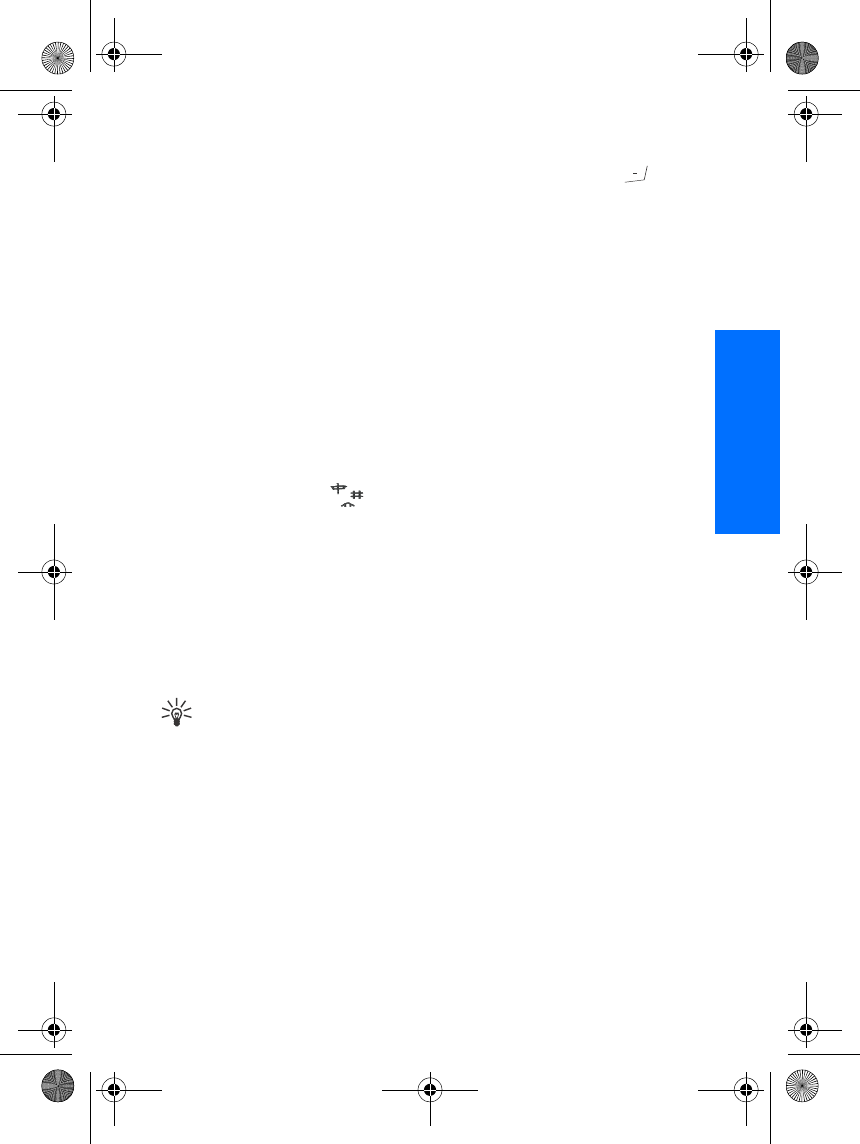
Menu functions
57
English
4. Enter the second number.
5. For a total, press Options and
select Equals. Repeat steps 3 to
5 as many times as is necessary.
6. To start a new calculation, first
press and hold Clear.
Performing a currency
conversion
1. Press Menu, and select Extras
and Calculator.
2. To save the exchange rate, press
Options and select Exchange
rate. Select either of the
displayed options. Enter the
exchange rate, press for a
decimal point, and press OK.
The exchange rate remains in
the memory until you replace it
with another one.
3. To perform the currency
conversion, enter the amount to
be converted, press Options and
select In domestic or In foreign.
Tip: You can also perform
the currency conversion in
standby mode. Key in the
amount to be converted,
press Options and select In
domestic or In foreign.
Stopwatch
You can measure time, take
intermediate times or lap times
using the stopwatch. During timing,
the other functions of the phone can
be used. To set the stopwatch timing
in the background, press .
Using the stopwatch consumes the
battery and the phone's operating
time will be reduced. Be careful not
to let it run in the background when
performing other operations with
your phone.
Time observation and time
splitting
1. Press Menu, and select Extras,
Stopwatch and Split timing. You
can select Continue if you have
set the timing in the background.
2. Press Start to start the time
observation. Press Split every
time you want to take an
intermediate time. The
intermediate times are listed
below the running time on the
display. Scroll to view the times.
3. Press Stop to stop the time
observation.
4. Press Options and select
Start to start the time
observation again. The new time
is added to the previous time.
Save to save the time. Enter a
name for the measured time and
press OK. If no name is keyed
in, the total time is used as the
title.
Reset to reset the time without
saving it.
3108_Dufu_fcc_1.1.fm Page 57 Friday, October 24, 2003 2:20 AM
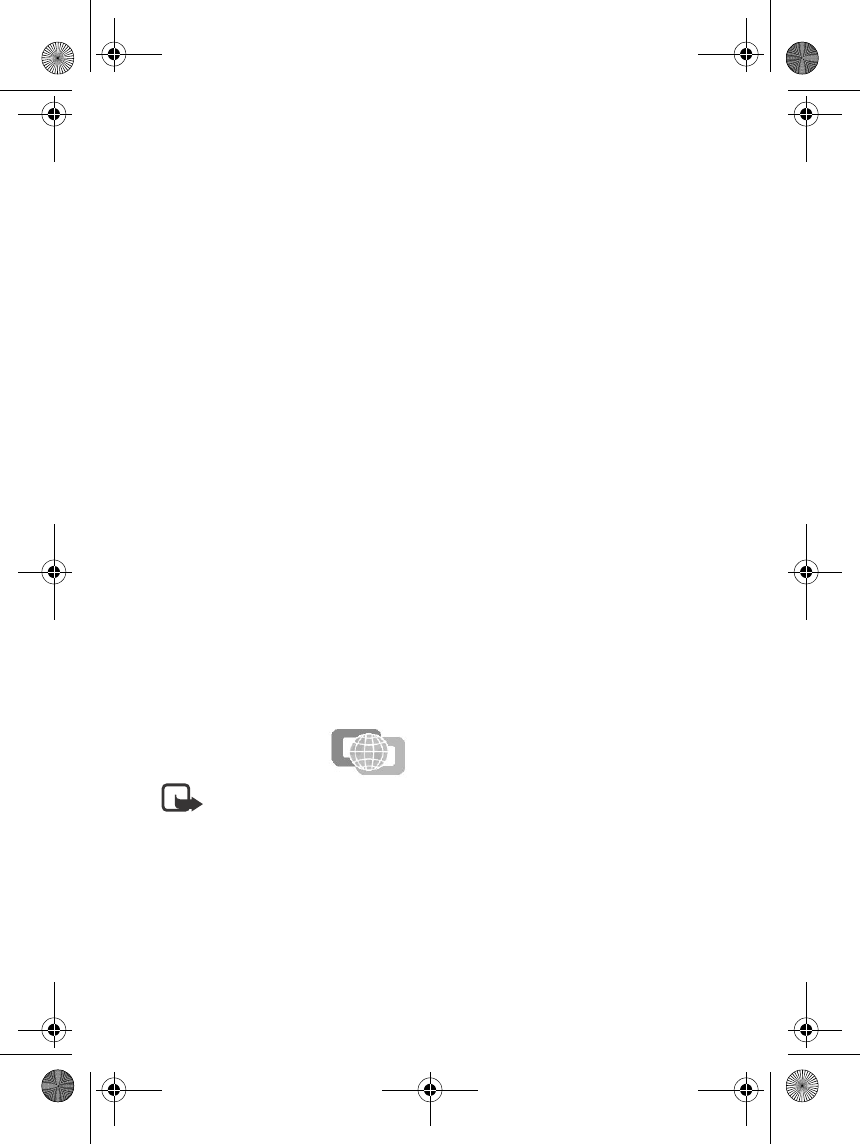
Menu functions
58
Lap times
Press Menu, and select Extras,
Stopwatch and Lap timing. Press
Start to start the time observation
and Lap to take a lap time. Press
Stop to stop the lap timing. Press
Options and you can save or reset
the lap times. Refer to ”Time
observation and time splitting”
above.
Viewing and deleting times
Press Menu, and select Extras, and
Stopwatch.
If the stopwatch is not reset, you
can select Show last to view the
most recent measured time. Select
View times and a list of names or
final times of the time sets is shown,
select the time set you want to view.
To delete the saved times, select
Delete times. Select Delete all and
press OK, or select One by one,
scroll to the times you want to
delete, press Delete and press OK.
■Services
(Menu 12)
Note: Your
phone must be switched on
to use this function. Do not
switch the phone on when wireless
phone use is prohibited or when it
may cause interference or danger.
You can access various services on
the Internet. For example, these
services may include weather
reports, news or flight times and
financial information.
Check the availability of these
services, pricing and tariffs with
your network operator and/or
service providers whose service
you wish to use. Service provider
will also give you instructions on
how to use their services.
Note that your phone may have
some pre-installed bookmarks for
sites not affiliated to Nokia. Nokia
does not warrant or endorse these
sites. If you choose to access them,
you should take the same
precautions, for security or content,
as you would with any Internet site.
With your phone’s multi-mode
browser you can view the services
that use Wireless Mark-up
Language (WML) or extensible
HyperText Markup Language
(xHTML) on their pages. Since the
phone’s display and the memory
capacity are much smaller than in a
computer, the content may be
shown differently on the phone’s
display. Note that you may not be
able to view all pages or all details
on the Internet pages.
Basic steps for accessing
and using services
1. Save the service settings that are
required to access the service
that you want to use. See page
59.
3108_Dufu_fcc_1.1.fm Page 58 Friday, October 24, 2003 2:20 AM
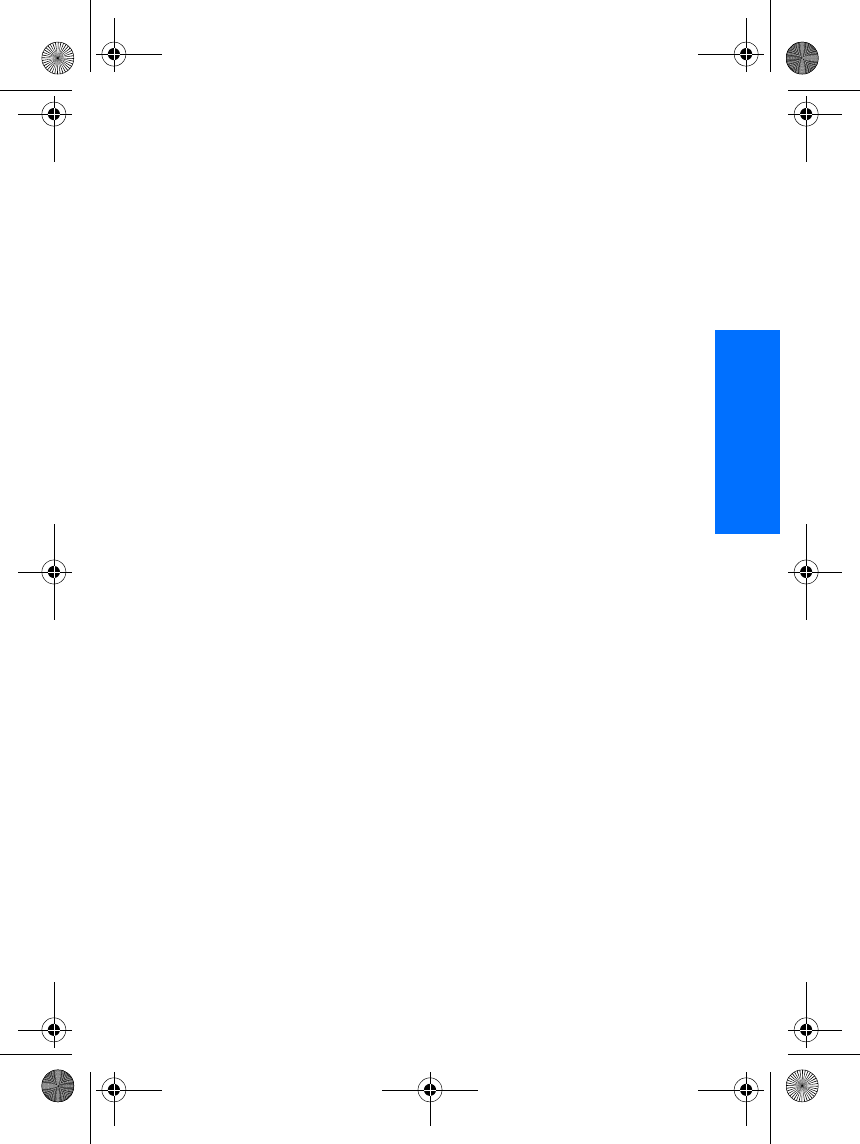
Menu functions
59
English
2. Make a connection to the given
service. See page 60.
3. Start browsing the pages of the
service. See page 60.
4. Once you are finished browsing,
end the connection to the
service. See page 62.
Setting up the phone for a
service
You may receive the service
settings as an OTA message from
the network operator or service
provider that offers the service that
you want to use. You can also key in
the settings manually or add and
edit the settings with PC Suite.
For more information and for
appropriate settings, contact your
network operator or service
provider that offers the service that
you want to use. The settings may
be available, for example, on their
website.
Saving the service settings
received as an OTA message
When you receive the service
settings as an OTA message,
Service settings received is
displayed.
• To save the received settings,
press Options and select Save.
If no settings are saved in Active
service settings, the settings are
saved under the first free
connection set and are also
activated.
If there are settings saved in
Active service settings, Activate
saved service settings? will be
displayed. To activate the saved
settings, press Yes , or to save
them only, press No.
• To view the received settings
first, press Options and select
View. To save the settings, press
Save.
• To discard the received settings,
press Options and select
Discard.
Keying in the service settings
manually
1. Press Menu, and select Services,
Settings and Connection
settings.
2. Select Active service settings.
3. Scroll to the connection set you
would like to activate and press
Activate.
You need to activate the
connection set where you want
to save the service settings. A
connection set is a collection of
settings required to make a
connection to a service.
4. Select Edit active service
settings.
Select each of the settings one
by one and key in all the
required settings according to
the information you have
3108_Dufu_fcc_1.1.fm Page 59 Friday, October 24, 2003 2:20 AM

Menu functions
60
received from your network
operator or service provider.
Note that all the bearer-related
settings are in the Bearer
settings menu.
GPRS Connection
You can set the phone to
automatically register to a GPRS
network when you switch the phone
on (network service). Press Menu,
and select Services, Settings,
Connection settings, GPRS
connection and Always online.
When you start an application using
GPRS, the connection between
your phone and the network is
established, and data transfer is
possible. When you end the
application, GPRS connection is
ended but the registration to the
GPRS network remains.
If you select When needed, the
GPRS registration and connection
are established when an application
using GPRS needs it and closed
when you end the application.
Making a connection to a
service
1. Firstly, make sure that the
service settings of the service
you want to use are activated. To
activate the settings:
•Press Menu, and select
Services, Settings and
Connection settings. Select
Active service settings and
scroll to the connection set
you want to activate and
press Activate.
2. Secondly, make a connection to
the service. There are three ways
to connect:
• Open the startpage, for
example, the homepage of
the service provider:
Press Menu, and select
Services and Home, or in
standby mode press and hold
.
• Select a bookmark of the
service:
Press Menu, and select
Services, Bookmarks, and
select a bookmark. See
“Bookmarks” on page 62.
• Key in the address of the
service:
Press Menu, and select
Services and then Go to
address. Key in the address
of the service and press OK.
Note that it is not necessary
to add the prefix http:// in
front of the address since it
will be added automatically.
Browsing the pages of a
service
After you have made a connection
to the service, you can start
browsing its pages. The function of
3108_Dufu_fcc_1.1.fm Page 60 Friday, October 24, 2003 2:20 AM

Menu functions
61
English
the phone keys may vary in
different services. Follow the text
guides on the phone display. For
more information, contact your
service provider.
Note that if GPRS is selected as the
data bearer, the indicator is
shown on the top left of the display
during browsing. If you receive a
call or a text message, or make a
call during a GPRS connection, the
indicator will be shown on the
top right of the display to indicate
that the GPRS connection is
suspended (on hold). After the call,
for example, the phone tries to
reconnect the GPRS connection.
Using the phone keys while
browsing
• Use any of the scroll keys to
browse through the page.
• To select a highlighted item,
press .
• To enter letters and numbers,
press the keys - and
to enter special characters, press
the key .
Options while browsing
Press Options and the following
options may be available. The
service provider may also offer
other options. Select
•Home to return to the homepage.
•Add bookmark to save the page
as a bookmark.
•Bookmarks. See ”Bookmarks”
on page 62.
•Download links to show the list
of bookmarks for downloading.
•Save to folder to save the current
page as a bookmark into a folder.
•Shortcuts to open a new list of
options that are, for example,
specific to the page.
•Other options to show a list of
other options, for example, some
security options.
•Reload to reload and update the
current page.
•Quit. See ”Disconnect from a
service” on page 62.
Note: If you have tried to
access or have accessed
confidential information
requiring passwords (for
example, your bank
account), empty the cache of your
phone after each use.
To empty the cache, see ”The cache
memory” on page 64.
Direct calling
The multi-mode browser supports
functions that you can access while
browsing. You can make a voice
call, send DTMF tones while a
voice call is in progress, and save a
name and a phone number from a
page in contacts.
3108_Dufu_fcc_1.1.fm Page 61 Friday, October 24, 2003 2:20 AM

Menu functions
62
Disconnect from a service
To quit browsing and to end the
connection, press Options and
select Quit. When Quit browsing?
is shown, press Yes .
Alternatively, press . The phone
ends the connection to the service.
Appearance settings of the
multi-mode browser
1. While browsing, press Options
and select Other options and
Appear. settings,
or in standby mode, press Menu,
and select Services, Settings and
Appearance settings.
2. Select Text wrapping. Select On
and the text continues on the
next line if it cannot be shown on
one line. If you select Off, the
text is abbreviated if it is too
long to be shown on one line.
Select Show images. Select No
and any pictures appearing on
the page are not shown. This can
speed up the browsing of pages
that contain a lot of pictures.
Cookies
A cookie is data that a site saves in
your phone’s browser cache
memory. The data can be, for
example, your user information or
your browsing preferences.
Cookies will be saved until you
clear the cache memory, see ”The
cache memory” on page 64.
1. While browsing, press Options
and select Other options,
Security and Cookies,
or in standby mode, press Menu,
and select Services, Settings,
Security settings and Cookies.
2. Select Allow or Reject to allow
or prevent the phone receiving
cookies.
Bookmarks
You can save page addresses as
bookmarks in the phone’s memory.
1. While browsing, press Options
and select Bookmarks,
or in standby mode, press Menu,
and select Services and
Bookmarks.
2. Scroll to the bookmark you want
to use and press Options.
3. Select Go to to make a
connection to the page
associated with the bookmark.
You can also view the title and
the address of the selected
bookmark, edit or delete the
selected bookmark, or send it
directly to another phone as a
bookmark, or as an OTA
message, or create a new
bookmark.
If the bookmark does not work with
the current active service settings,
3108_Dufu_fcc_1.1.fm Page 62 Friday, October 24, 2003 2:20 AM

Menu functions
63
English
activate another set of service
settings and try again.
Note that your phone may have
some pre-installed bookmarks for
sites not affiliated to Nokia. Nokia
does not warrant or endorse these
sites. If you choose to access them,
you should take the same
precautions, for security or content,
as you would with any Internet site.
Receiving a bookmark
When you have received a
bookmark (sent as a bookmark
from a compatible device) 1
bookmark received is displayed.
Press View, then press Options and
select View to view the bookmark,
Save to save the bookmark, or
Discard to discard it.
Downloading
1. To download more tones,
images, games or applications to
your phone, press Menu, and
select Services and Download
links.
2. Select Tone downloads, Graphic
downloads, Game downloads or
App. downloads to download
tones, images, games or
applications, respectively.
Download content only from the
sources you trust.
Note that copyright protections may
prevent some images, ringing tones
and other content from being
copied, modified, transferred or
forwarded.
Service inbox
The phone is able to receive service
messages (pushed messages) sent
by your service provider (network
service). Service messages may be
notifications of, for example, news
headlines, and they may contain a
text message or an address of a
service.
To access the Service inbox in
standby mode, when you have
received a service message, press
Show.
• If you press Exit the message is
moved to the Service inbox. To
access the Service inbox later,
press Menu, and select Services,
Settings and Service inbox.
To access the Service inbox while
browsing, press Options and
select Other options and Service
inbox. Scroll to the message you
want, press Options. Select Retrieve
to activate the multi-mode browser
and download the marked content,
or Details to display detailed
information on the service
notification, or select Delete to
delete it.
Service inbox settings
Press Menu, and select Services,
Settings and Service inbox settings.
3108_Dufu_fcc_1.1.fm Page 63 Friday, October 24, 2003 2:20 AM

Menu functions
64
• Select Service messages and On
(or Off) to set the phone to
receive (or not to receive)
service message.
• Select Automatic connection. If
you have set the phone to
receive service messages and
select Automatic connection on,
the phone will automatically
activate the browser when the
phone has received a service
message.
If you select Automatic
connection off, the phone will
activate the browser only after
you have selected Retrieve when
the phone has received a service
message.
The cache memory
The information or services you
have accessed are stored in the
cache of your phone. A cache is a
buffer memory, which is used to
store data temporarily. To empty the
cache:
• while browsing, press Options
and select Other options and
Clear the cache, or
• in standby mode, press Menu,
and select Services, and Clear
the cache.
Browser security
Security features may be required
for some services, such as banking
services or shopping on a site. For
such connections you need security
certificates and possibly a security
module which may be available on
your SIM card. For more
information, contact your service
provider.
Security module
The security module can contain
certificates as well as private and
public keys. The security module
may improve the security services
for applications requiring browser
connection, and allows you to use a
digital signature. The certificates
are saved in the security module by
the service provider.
Press Menu and select Services,
Settings, Security settings and
Security module settings. Select
•Security module details to show
the security module title, its
status, manufacturer and serial
number.
•Module PIN request to set the
phone to ask for the module PIN
when using services provided by
security module. Key in the code
and select On. To disable the
module PIN request, select Off.
•Change module PIN to change
the module PIN, if allowed by
the security module. Enter the
current module PIN code, then
enter the new code twice.
3108_Dufu_fcc_1.1.fm Page 64 Friday, October 24, 2003 2:20 AM
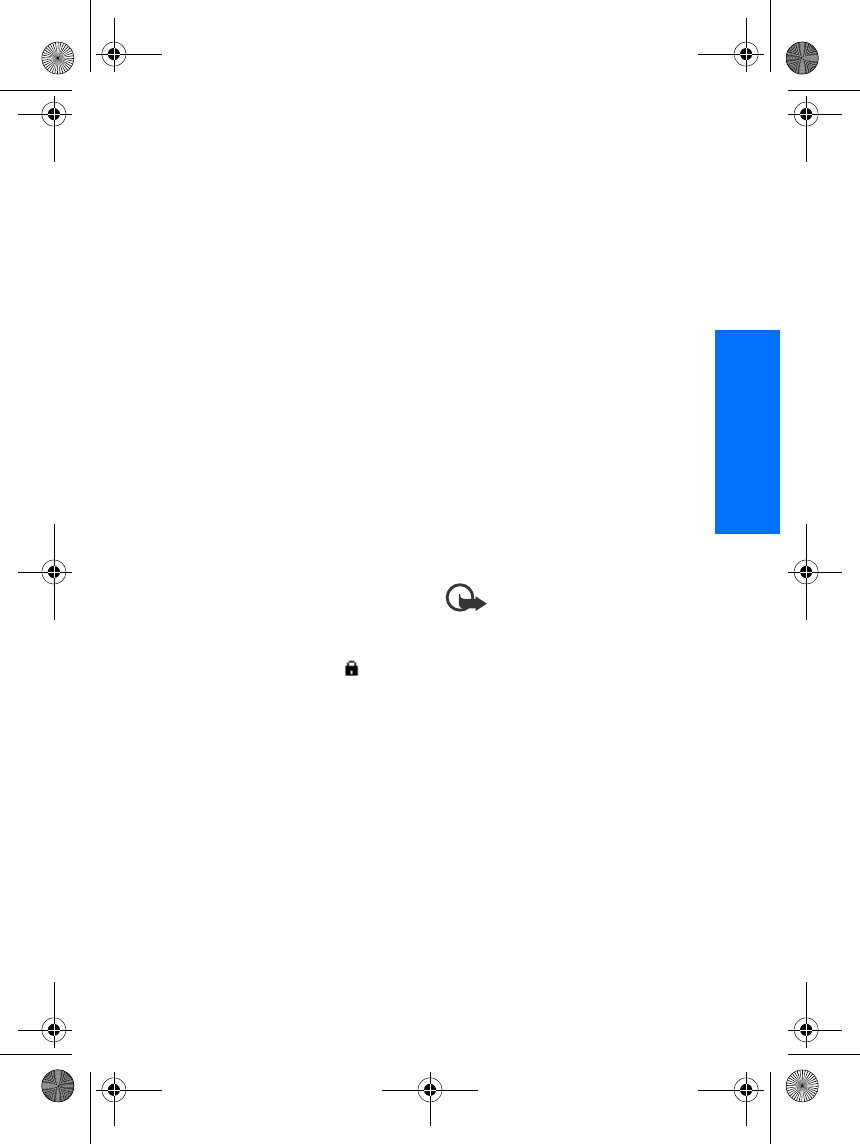
Menu functions
65
English
•Change signing PIN. Select the
signing PIN you want to change.
Enter the current PIN code, then
enter the new code twice.
See also ”General information” on
page -1.
Certificates
There are three kinds of certificates:
server certificates, authority
certificates and user certificates.
• The phone uses a server
certificate to improve security in
connection between the phone
and the gateway. The phone
receives the server certificate
from the service provider before
the connection is established and
its validity is checked using the
authority certificates saved in
the phone. Server certificates are
not saved.
The security indicator is
displayed during a connection, if
the data transmission between
the phone and the gateway
(identified by the IP address in
the Edit active service settings -
Bearer settings) is encrypted.
However, the security indicator
does not indicate that the data
transmission between the
gateway and the content server
(place where the requested
resource is saved) is secure. It is
up to the service provider to
secure the data transmission
between the gateway and the
content server.
• Authority certificates are used
by some services, such as
banking services, for checking
the validity of other certificates.
Authority certificates can either
be saved in the security module
by the service provider, or they
can be downloaded from the
network, if the service supports
the use of authority certificates.
• User certificates are issued to
users by a Certifying Authority.
User certificates are required,
for example, to make a digital
signature and they associate the
user with a specific private key
in a security module.
Important: Note, however,
that even if the use of
certificates makes the risks
involved in remote
connections and software
installation considerably
smaller, they must be used
correctly in order to benefit
from increased security.
The existence of a
certificate does not offer
any protection by itself; the
certificate manager must
contain correct, authentic,
or trusted certificates for
increased security to be
available.
3108_Dufu_fcc_1.1.fm Page 65 Friday, October 24, 2003 2:20 AM

Menu functions
66
Important: Certificates have a
restricted lifetime. If Expired
certificate or Certificate not valid
yet is shown even if the certificate
should be valid, check that the
current date and time in your phone
are correct.
Important: Before changing these
settings, you must make sure that
you really trust the owner of the
certificate and that the certificate
really belongs to the listed owner.
Digital signature
You can make digital signatures
with your phone (network service).
The signature can be traced back to
you via the private key on the
security module and the user
certificate that was used to perform
the signature. Using the digital
signature can be the same as signing
your name to a paper bill, contract
or other document.
To make a digital signature, select a
link on a page, for example, the title
of the book you want to buy and its
price. The text to sign (possibly
including amount, date, etc.) will be
shown.
Check that the header text is Read
and that the digital signature icon
is shown.
Note: If the digital
signature icon does not
appear, there is a security
breach, and you should not enter
any personal data such as your
signing PIN.
To sign the text, read all of the text
first and then you can select Sign.
Note: The text may not fit
within a single screen.
Therefore, make sure to
scroll through and read all of the
text before signing.
Select the user certificate you want
to use. Key in the signing PIN (see
”General information” on page -1)
and press OK. The digital signature
icon will disappear, and the service
may display a confirmation of your
purchase.
■SIM services
(Menu 13)
In addition to the functions
available in the phone, your SIM
card may provide additional
services that you can access in
Menu 15. Menu 15 is shown only if
it is supported by your SIM card.
The name and contents of the menu
depend entirely on the service
available.
Note: For availability, rates
and information on using
SIM services, contact your
SIM card vendor, e.g. network
operator, service provider or other
vendor.
3108_Dufu_fcc_1.1.fm Page 66 Friday, October 24, 2003 2:20 AM
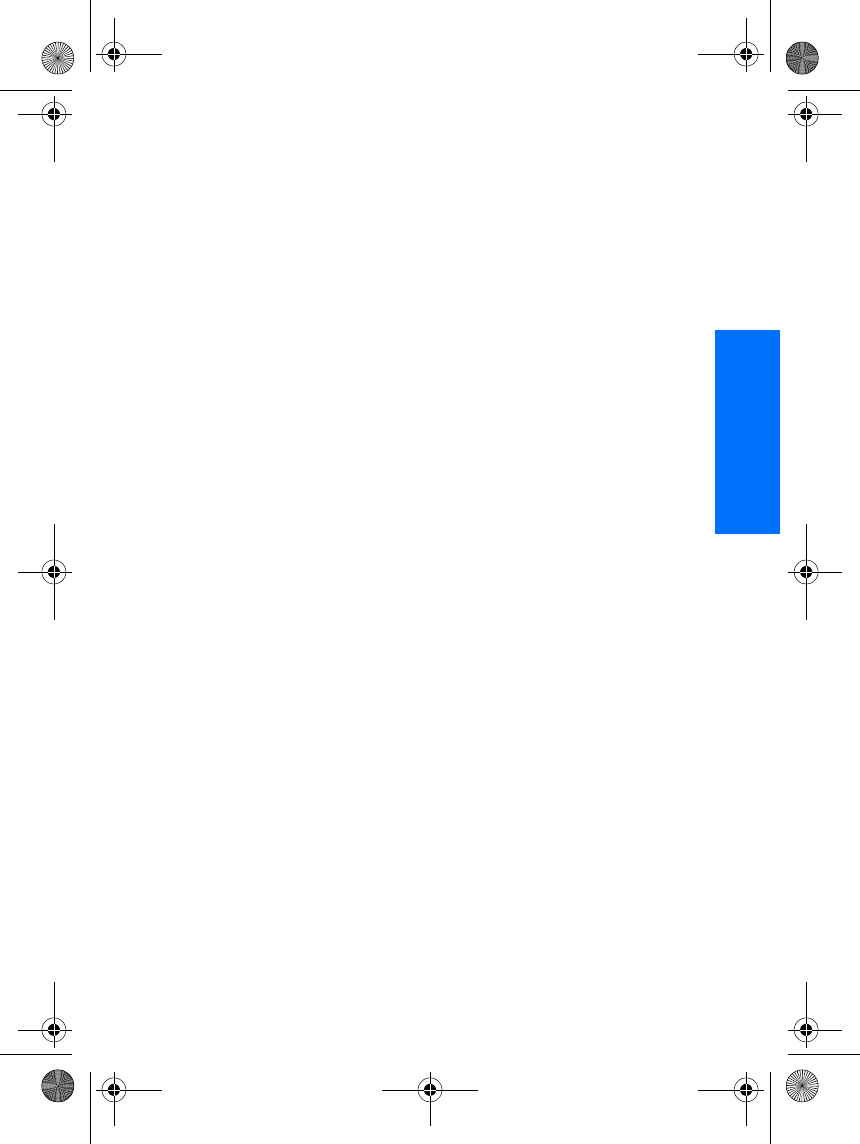
Menu functions
67
English
You can set the phone to show you
the confirmation messages sent
between your phone and the
network when you are using the
SIM services by selecting the
option Yes in the menu Confirm
SIM service actions in Phone
settings.
Note that accessing these services
may involve sending a text message
(SMS) or making a phone call for
which you may be charged.
3108_Dufu_fcc_1.1.fm Page 67 Friday, October 24, 2003 2:20 AM

PC connectivity
68
7. PC connectivity
When your phone is connected to a
compatible PC via a data cable, you
can use your phone with a variety of
PC connectivity and data
communications applications. With
PC Suite you can, for example, send
text messages, synchronise contacts
and calendar between your phone
and the PC, and manage your WAP
bookmarks and connection sets.
You may find more information and
downloadable files on the Nokia
website, http://www.nokia.com.
■PC Suite
The PC Suite contains the
following applications:
•Nokia Application Installer to
install Java applications from a
compatible PC to the phone.
•Nokia Image Converter to
make images usable for
multimedia messages, wallpaper
or operator logos and to transfer
them to your phone.
•Nokia Sound Converter to edit
polyphonic ringing tones to be
compatible with your phone and
to transfer them to your phone.
•Nokia Content Copier to copy
information or back-up
information from your phone to
a compatible PC or to another
compatible Nokia phone.
•Nokia PC WAP Manager to
edit and send your WAP
bookmarks or update the
connection sets to your phone.
•Nokia Phone Editor to send
text messages and edit the phone
book and message settings of
your phone.
•Nokia Phone Browser to view
the contents of the Gallery
folder of your phone on the PC.
•Nokia PC Sync to synchronise
the compatible phone book and
calendar between your phone
and PC.
•Nokia Connection Manager to
select the connection type
between the PC and the phone.
Note that copyright protections may
prevent some images, ringing tones
and other content from being
copied, modified, transferred or
forwarded.
GPRS, HSCSD and CSD
With your phone you can use GPRS
(General Packet Radio Service),
HSCSD (High Speed Circuit
Switched Data), and CSD (Circuit
Switched Data, GSM data) data
services.
3108_Dufu_fcc_1.1.fm Page 68 Friday, October 24, 2003 2:20 AM
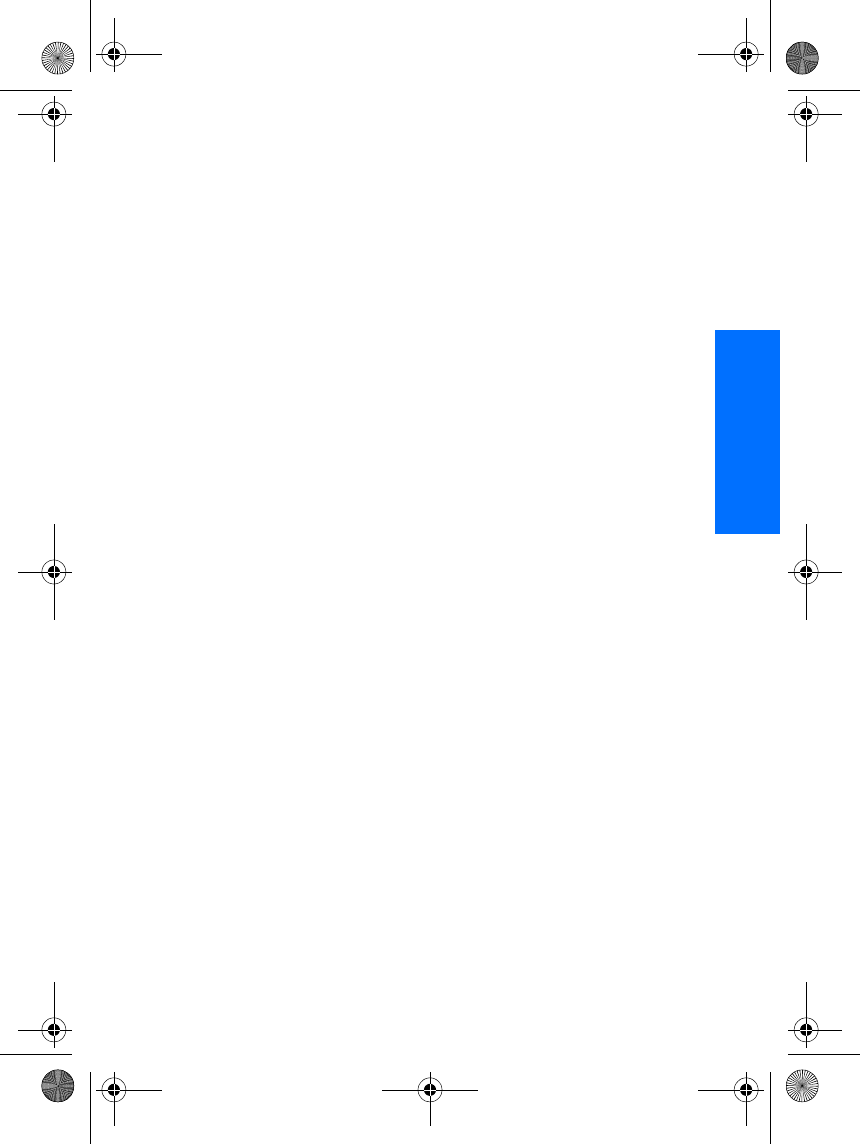
PC connectivity
69
English
For availability and subscription to
data services, contact your network
operator or service provider.
Note that the use of HSCSD service
consumes the phone’s battery faster
than normal voice or data calls. You
may need to connect the phone to a
charger for the duration of data
transfer.
■Use data
communication
applications
For information on using a data
communication application, refer to
the documentation provided with it.
1. If you use the cable DKU-5:
• Connect the cable to the USB
port on the back of a
compatible computer and to
the connector on your phone.
2. Start using the data
communications application on
the computer.
Note that making or answering
phone calls during a computer
connection is not recommended as
it might disrupt the operation.
For a better performance during
data calls, place the phone on a
stationary surface with the keypad
facing downward. Do not move the
phone or hold it in your hand during
a data call.
3108_Dufu_fcc_1.1.fm Page 69 Friday, October 24, 2003 2:20 AM

Battery information
70
8. Battery information
■Charging and
Discharging
Your phone is powered by a
rechargeable battery.
Note that a new battery's full
performance is achieved only after
two or three complete charge and
discharge cycles!
The battery can be charged and
discharged hundreds of times but it
will eventually wear out. When the
operating time (talk-time and
standby time) is noticeably shorter
than normal, it is time to buy a new
battery.
Use only batteries approved by the
phone manufacturer and recharge
your battery only with the chargers
approved by the manufacturer.
Unplug the charger when not in use.
Do not leave the battery connected
to a charger for longer than a week,
since overcharging may shorten its
lifetime. If left unused a fully
charged battery will discharge itself
over time.
Temperature extremes can affect
the ability of your battery to charge.
Use the battery only for its intended
purpose.
Never use any charger or battery
which is damaged.
Do not short-circuit the battery.
Accidental short-circuiting can
occur when a metallic object (coin,
clip or pen) causes direct
connection of the + and - terminals
of the battery (metal strips on the
battery) for example when you
carry a spare battery in your pocket
or purse. Short-circuiting the
terminals may damage the battery
or the connecting object.
Leaving the battery in hot or cold
places, such as in a closed car in
summer or winter conditions, will
reduce the capacity and lifetime of
the battery. Always try to keep the
battery between 15°C and 25°C
(59°F and 77°F). A phone with a
hot or cold battery may temporarily
not work, even when the battery is
fully charged. Batteries'
performance is particularly limited
in temperatures well below
freezing.
Do not dispose of batteries in a fire!
Dispose of batteries according to
local regulations (e.g. recycling).
Do not dispose as household waste.
3108_Dufu_fcc_1.1.fm Page 70 Friday, October 24, 2003 2:20 AM

Genuine Enhancements
71
English
9. Genuine Enhancements
A new extensive
range of
enhancements is
available for your
phone. Select the
enhancements
which accommodate your specific
communication needs.
Some of the enhancements are
described in detail below.
For availability of the
enhancements, please check with
your local dealer. A few practical
rules for enhancements operation:
• When you disconnect the power
cord of any enhancement, grasp
and pull the plug, not the cord.
• Check regularly that all mobile
phone equipment in a vehicle is
mounted and operating properly.
Use only batteries, chargers and
accessories approved by the
phone manufacturer. The use of
any other types may invalidate
any approval or warranty
applying to the phone, and may
be dangerous.
■Battery
* Variation in operation times may
occur depending on SIM card,
network and usage settings, usage
style and environments. Use of the
Loudspeaker feature will affect
talktime and standby time.
■Travel Charger (ACP-
12)
Small, lightweight travel charger
with multi voltage (100 - 240V)
switcher technology. Provides easy
and convenient way to charge the
phone.
Note: The plug types vary
according to different markets.
Type Tech Capa
city
Talk-
time *
Stand
by *
BL-
4C
Li-
lon
760
mAh
2.6-4.2
hours
160-
370
hours
3108_Dufu_fcc_1.1.fm Page 71 Friday, October 24, 2003 2:20 AM
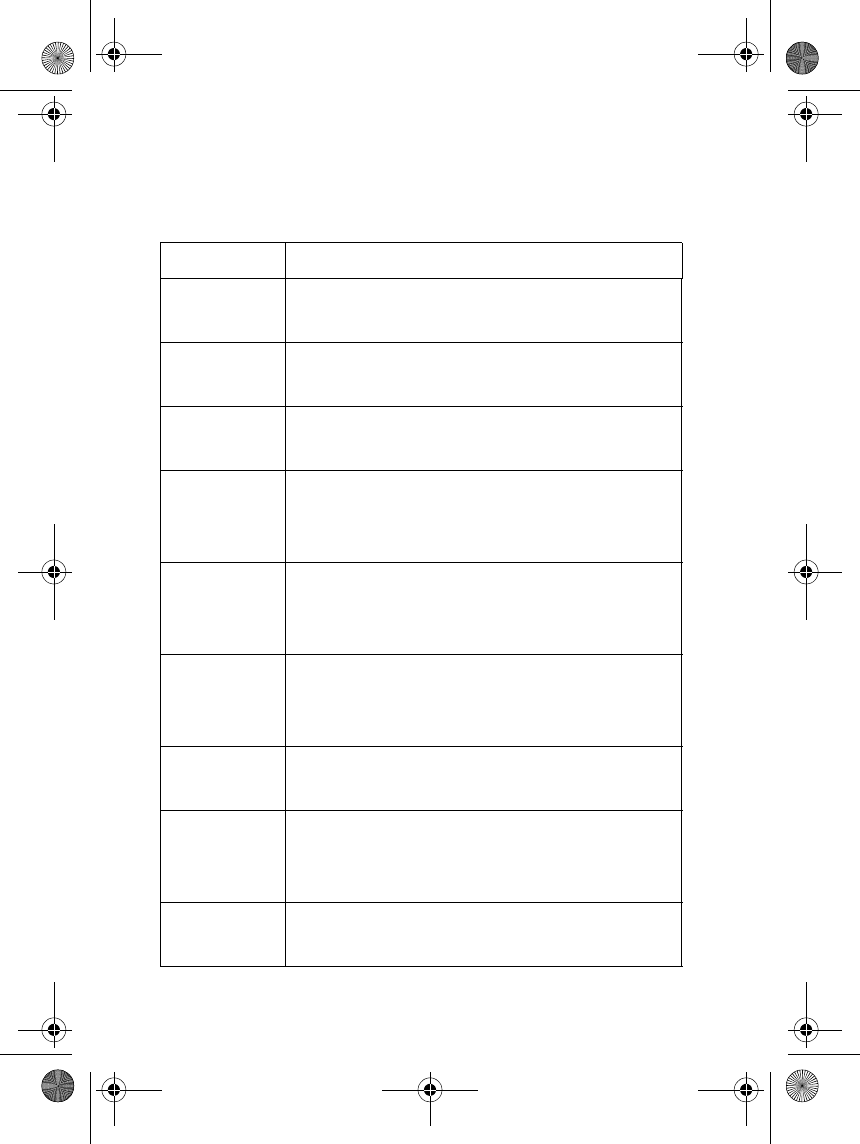
Technical Information
72
10. Technical Information
Feature Specification
Weight 7.8 ounces (95 grams) with BL-4C 760
mAh Li-polymer Battery
Networks Wireless networks GSM 900,1800
and1900
Size (vol-
ume)
5.11 cubic inches (83.6 cc)
Frequency
range (Tx)
GSM 900: 880 - 915 Mhz
GSM 1800: 1710 - 1785 Mhz
GSM1900: 1850 - 1910 Mhz
Frequency
range (Rx)
GSM 900: 925 - 960 Mhz
GSM1800: - 1805 - 1880 Mhz
GSM1900: - 1930 - 1990 Mhz
Tx output
power
EGSM 900: 2W (peak)
GSM1800: 1W (peak)
GSM1900: 1W(peak)
Battery
voltage
3.7 v DC
Number of
channels
EGSM 900: 174
GSM1800: 374
GSM1900: 299
Memory
locations
up to 300 in phone memory
3108_Dufu_fcc_1.1.fm Page 72 Friday, October 24, 2003 2:20 AM

Patents
73
English
11. Patents
4558302
4868846
4969192
5001372
5045973
5061928
5101175
5212834
5230091
5233634
5241284
5241583
5303404
5311179
5331638
5335362
5353328
5384782
5390223
5396657
5400949
5416435
5442521
5444816
5446364
5479476
5487084
5493255
5519885
5526366
5553125
5557639
5581244
5625274
5640395
5664053
5669069
5677620
5692032
5699406
5699482
5701392
5729534
5729541
5734683
5754976
5760568
5782646
5794142
5802465
5805084
5805301
5818437
5827082
5835889
5839101
5844884
5845219
5857151
5862178
5870683
5887266
5889770
5892475
5898925
5907823
5914796
5915440
5917868
5920826
5926138
5926769
5930233
5946651
5953541
5956625
5956633
5960389
5963901
5966374
5966378
5969192
5970059
5987137
5991716
5991857
5999523
6005857
6011554
6011853
6014573
6026161
6028567
6029128
6038238
6043760
Manufactured or sold under one or more of the following US Patents:
3108_Dufu_fcc_1.1.fm Page 73 Friday, October 24, 2003 2:20 AM

Patents
74
6047196
6049796
6055439
6060193
6069923
6081534
6084962
6088746
6094587
6097964
6112099
6115617
6118775
6122498
6128322
6128509
6138091
6144243
6144676
6151485
6151507
6163609
6164547
6167248
6170073
6185295
6188909
6195338
6199035
6201876
6219560
6240076
6240079
6249584
6266330
6282373
6289205
6292668
6295286
6310609
6324412
D406261
D425480
D426830
D445415 RE32580
CN03109865.7 (a patent
application, based on the
same technical contents
of patent application
CN03109865.7 will be
made to the US Patent
and Trademark Office
before April 14 of 2004.)
CN 03109865.7
CN 03130728.0
CN 03123518.2
3108_Dufu_fcc_1.1.fm Page 74 Friday, October 24, 2003 2:20 AM
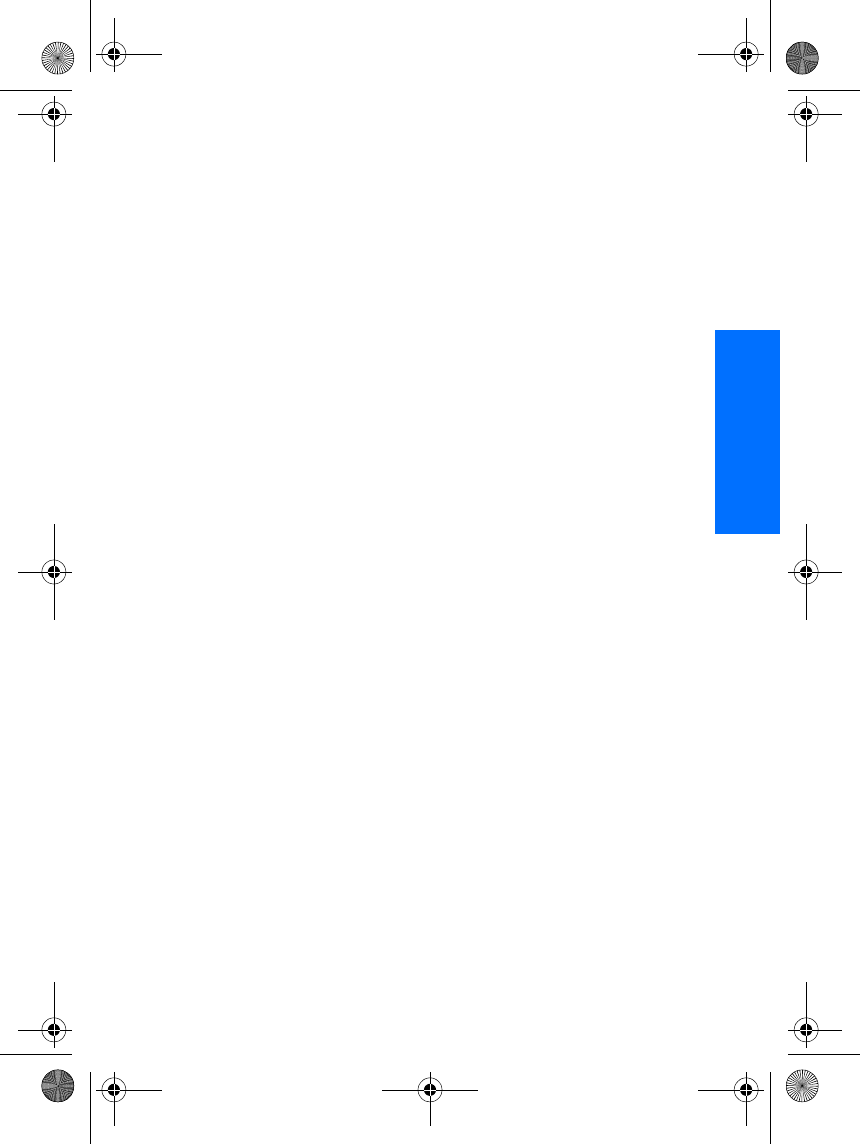
CARE AND MAINTENANCE
75
English
12. CARE AND MAINTENANCE
Your phone is a product of superior
design and craftsmanship and should be
treated with care. The suggestions
below will help you to fulfil any
warranty obligations and to enjoy this
product for many years.
• Keep the phone and all its parts and
accessories out of the reach of small
children.
• Keep the phone dry. Precipitation,
humidity and all types of liquids or
moisture can contain minerals that
will corrode electronic circuits.
• Do not use or store the phone in
dusty, dirty areas. Its moving parts
can be damaged.
• Do not store the phone in hot areas.
High temperatures can shorten the
life of electronic devices, damage
batteries, and warp or melt certain
plastics.
• Do not store the phone in cold areas.
When it warms up (to its normal
temperature), moisture can form
inside, which may damage
electronic circuit boards.
• Do not attempt to open the phone.
Non-expert handling may damage it.
• Do not drop, knock or shake the
phone. Rough handling can break
internal circuit boards.
• Do not use harsh chemicals,
cleaning solvents, or strong
detergents to clean the phone.
• Do not paint the phone. Paint can
clog the moving parts and prevent
proper operation.
• Use only the supplied or an
approved replacement antenna.
Unauthorised antennas,
modifications or attachments could
damage the phone and may violate
regulations governing radio devices.
• Keep the flip of the phone closed and
store the stylus in its holder when not
in use.
• Use only a stulys that has been
approved by Nokia to be used in
connection with the phone. Never
use an actual pen or pencil or other
sharp objects to write on the touch
pad.
All of the above suggestions apply
equally to your phone, battery, charger
or any accessorie. If any of them is not
working properly, take it to your nearest
qualified service facility. The personnel
there will assist you and, if necessary,
arrange for service.
3108_Dufu_fcc_1.1.fm Page 75 Friday, October 24, 2003 2:20 AM

IMPORTANT SAFETY INFORMATION
76
13. IMPORTANT SAFETY
INFORMATION
■Traffic Safety
Do not use a hand-held telephone while
driving a vehicle. Always secure the
phone in its holder; do not place the
phone on the passenger seat or where it
can break loose in a collision or sudden
stop.
Remember road safety always comes
first!
■Operating environment
Remember to follow any special
regulations in force in any area and
always switch off your phone whenever
it is forbidden to use it, or when it may
cause interference or danger.
Use the phone only in its normal
operating positions.
Parts of the phone are magnetic.
Metallic materials may be attracted to
the phone, and persons with a hearing
aid should not hold the phone to the ear
with the hearing aid. Always secure the
phone in its holder, because metallic
materials may be attracted by the ear
piece. Do not place credit cards or other
magnetic storage media near the phone,
because information stored on them
may be erased.
■Electronic devices
Most modern electronic equipment is
shielded from radio frequency (RF)
signals. However, certain electronic
equipment may not be shielded against
the RF signals from your wireless
phone.
Pacemakers
Pacemaker manufacturers recommend
that a minimum separation of 20 cm (6
inches) be maintained between a
handheld wireless phone and a
pacemaker to avoid potential
interference with the pacemaker. These
recommendations are consistent with
the independent research by and
recommendations of Wireless
Technology Research.
Persons with pacemakers:
• Should always keep the phone more
than 20 cm (6 inches) from their
pacemaker when the phone is
switched on;
• Should not carry the phone in a
breast pocket;
• Should use the ear opposite the
pacemaker to minimise the potential
for interference.
• Should switch off the phone
immediately if there is any reason to
suspect that interference is taking
place.
Hearing aids
Some digital wireless phones may
interfere with hearing aids. In the event
of such interference, you may want to
consult your service provider.
3108_Dufu_fcc_1.1.fm Page 76 Friday, October 24, 2003 2:20 AM
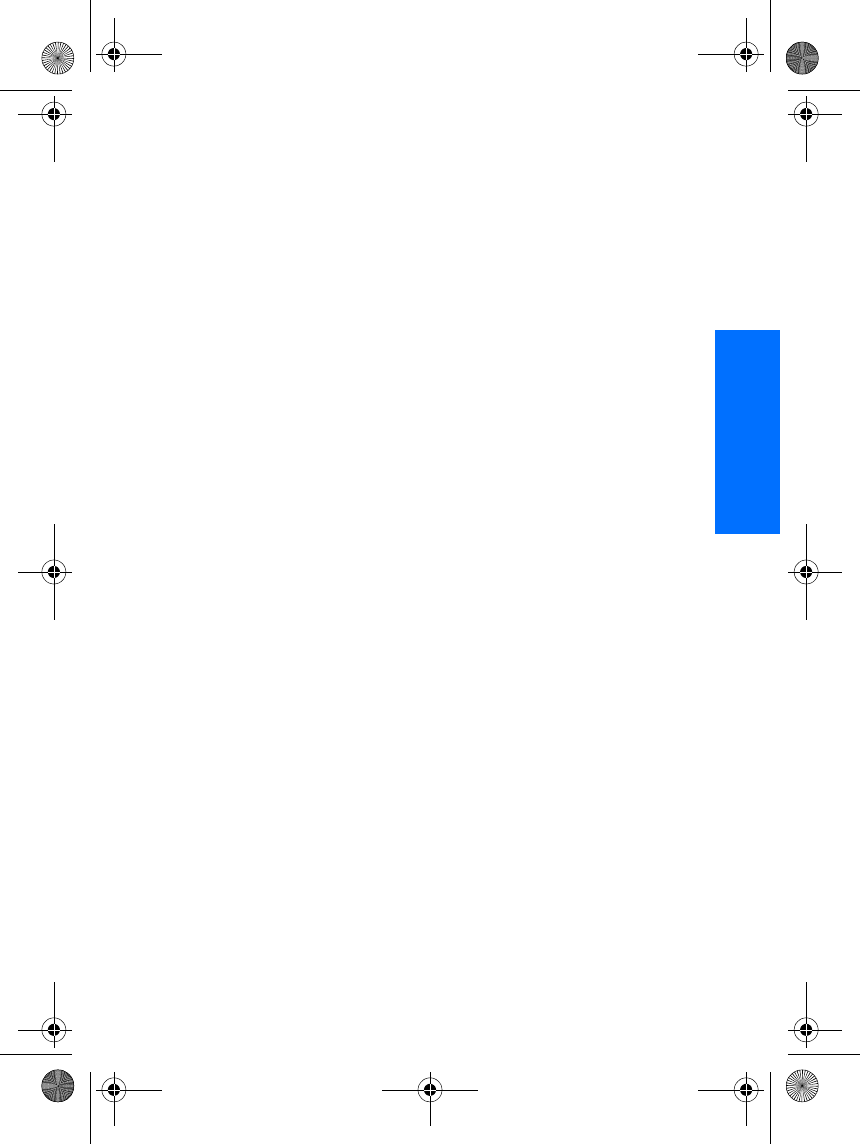
IMPORTANT SAFETY INFORMATION
77
English
Other medical devices
Operation of any radio transmitting
equipment, including cellular phones,
may interfere with the functionality of
inadequately protected medical devices.
Consult a physician or the manufacturer
of the medical device to determine if
they are adequately shielded from
external RF energy or if you have any
questions. Switch off your phone in
health care facilities when any
regulations posted in these areas instruct
you to do so. Hospitals or health care
facilities may be using equipment that
could be sensitive to external RF energy.
Vehicles
RF signals may affect improperly
installed or inadequately shielded
electronic systems in motor vehicles
(e.g. electronic fuel injection systems,
electronic anti-skid (anti-lock) braking
systems, electronic speed control
systems, air-bag systems). Check with
the manufacturer or its representative
regarding your vehicle. You should also
consult the manufacturer of any
equipment that has been added to your
vehicle.
Posted facilities
Switch your phone off in any facility
where posted notices so require.
■Potentially explosive
atmospheres
Switch off your phone when in any area
with a potentially explosive atmosphere
and obey all signs and instructions.
Sparks in such areas could cause an
explosion or fire resulting in bodily
injury or even death.
Users are advised to switch off the
phone when at a refuelling point
(service station). Users are reminded of
the need to observe restrictions on the
use of radio equipment in fuel depots
(fuel storage and distribution areas),
chemical plants or where blasting
operations are in progress.
Areas with a potentially explosive
atmosphere are often but not always
clearly marked. They include below
deck on boats; chemical transfer or
storage facilities; vehicles using
liquified petroleum gas (such as propane
or butane); areas where the air contains
chemicals or particles, such as grain,
dust or metal powders; and any other
area where you would normally be
advised to turn off your vehicle engine.
■Vehicles
Only qualified personnel should service
the phone, or install the phone in a
vehicle. Faulty installation or service
may be dangerous and may invalidate
any warranty which may apply to the
unit.
Check regularly that all wireless phone
equipment in your vehicle is mounted
and operating properly.
Do not store or carry flammable liquids,
gases or explosive materials in the same
compartment as the phone, its parts or
accessories.
For vehicles equipped with an air bag,
remember that an air bag inflates with
great force. Do not place objects,
including both installed or portable
wireless equipment in the area over the
air bag or in the air bag deployment
3108_Dufu_fcc_1.1.fm Page 77 Friday, October 24, 2003 2:20 AM

IMPORTANT SAFETY INFORMATION
78
area. If in-vehicle wireless equipment is improperly installed and the air bag inflates,
serious injury could result.
Using your phone while in the air is prohibited. Switch off your phone before
boarding an aircraft. The use of wireless telephones in an aircraft may be dangerous
to the operation of the aircraft, disrupt the wireless telephone network and may be
illegal.
Failure to observe these instructions may lead to suspension or denial of telephone
services to the offender, or legal action or both.
■Aircraft
FCC regulations prohibit using your phone while in the air. Switch off your phone
before boarding an aircraft. The use of wireless telephones in an aircraft may be
dangerous to the operation of the aircraft, disrupt the wireless telephone network, and
may be illegal. Failure to observe these instructions may lead to suspension or denial
of telephone services to the offender, legal action, or both.
■Emergency calls
Important: This phone, like any wireless phone, operates using radio
signals, wireless and landline networks as well as user-programmed
functions. Because of this, connections in all conditions can not be
guaranteed. Therefore, you should never rely solely upon any wireless
phone for essential communications (e.g. medical emergencies).
Emergency calls may not be possible on all wireless phone networks or when certain
network services and/or phone features are in use. Check with local service providers.
To make an emergency call:
1. If the phone is not on, switch it on. Check for adequate signal strength.
Some networks may require that a valid SIM card is properly inserted in the
phone.
2. Press as many times as needed (e.g. to exit a call, to exit a menu, etc.) to clear
the display and ready the phone for calls.
3. Key in the emergency number for your present location (e.g. 911, or other official
emergency number). Emergency numbers vary by location.
4. Press the key.
If certain features are in use, you may first need to turn those features off before you
can make an emergency call. Consult this guide and your local cellular service
provider.
When making an emergency call, remember to give all the necessary information as
accurately as possible. Remember that your wireless phone may be the only means of
3108_Dufu_fcc_1.1.fm Page 78 Friday, October 24, 2003 2:20 AM
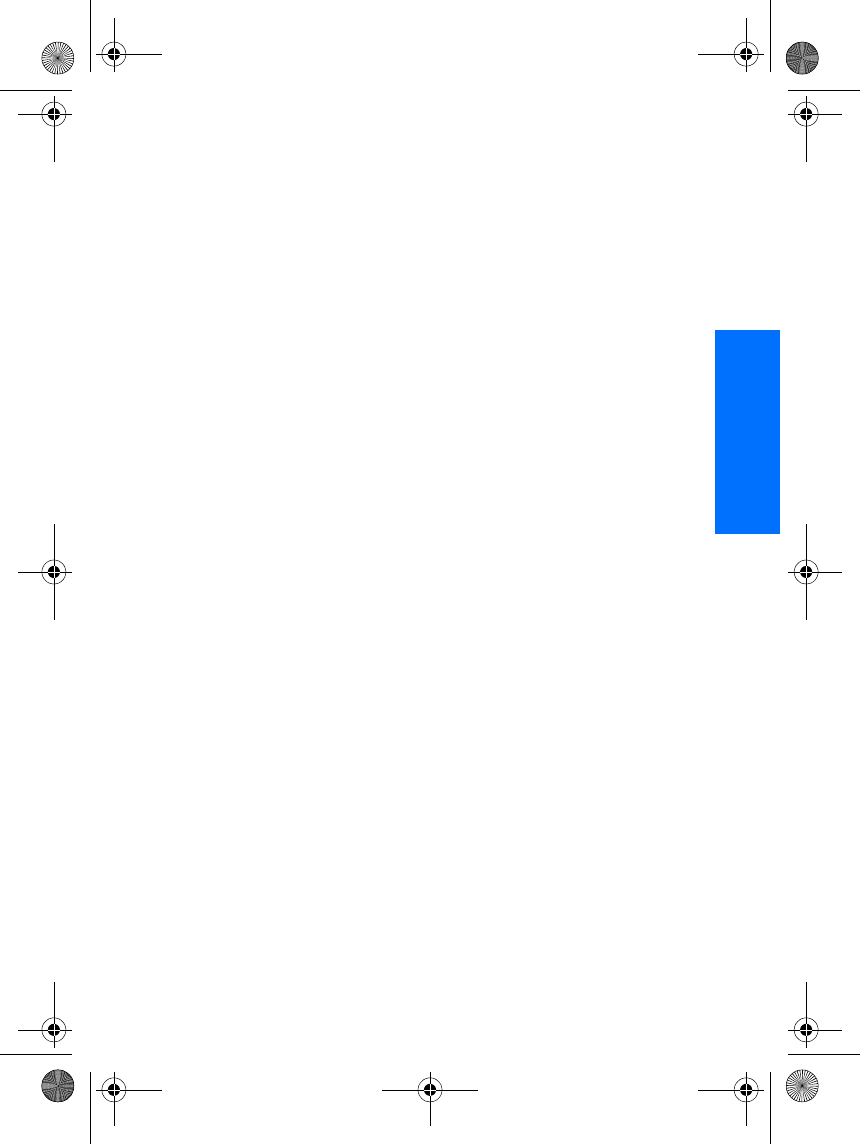
IMPORTANT SAFETY INFORMATION
79
English
communication at the scene of an accident - do not end the call until given permission
to do so.
3108_Dufu_fcc_1.1.fm Page 79 Friday, October 24, 2003 2:20 AM

IMPORTANT SAFETY INFORMATION
80
■Certification information
(SAR)
THIS MODEL PHONE MEETS
THE GOVERNMENT'S
REQUIREMENTS FOR
EXPOSURE TO RADIO WAVES.
Your wireless phone is a radio
transmitter and receiver. It is
designed and manufactured not to
exceed the emission limits for
exposure to radio frequency (RF)
energy set by the Federal
Communications Commission of
the U.S. Government. These limits
are part of comprehensive
guidelines and establish permitted
levels of RF energy for the general
population. The guidelines are
based on standards that were
developed by independent
scientific organizations through
periodic and thorough evaluation of
scientific studies. The standards
include a substantial safety margin
designed to assure the safety of all
persons, regardless of age and
health. The exposure standard for
wireless mobile phones employs a
unit of measurement known as the
Specific Absorption Rate, or SAR.
The SAR limit set by the FCC is
1.6W/kg.* Tests for SAR are
conducted using standard operating
positions accepted by the FCC with
the phone transmitting at its highest
certified power level in all tested
frequency bands. Although the
SAR is determined at the highest
certified power level, the actual
SAR level of the phone while
operating can be well below the
maximum value. This is because
the phone is designed to operate at
multiple power levels so as to use
only the power required to reach the
network. In general, the closer you
are to a wireless base station
antenna, the lower the power
output. Before a phone model is
available for sale to the public, it
must be tested and certified to the
FCC that it does not exceed the
limit established by the
government-adopted requirement
for safe exposure. The tests are
performed in positions and
locations (for example, at the ear
and worn on the body) as required
by the FCC for each model. The
highest SAR value for this model
phone as reported to the FCC when
tested for use at the ear is 0.61 W/kg
and when worn on the body, as
described in this user guide, is 0.94
W/kg. (Body-worn measurements
differ among phone models,
depending upon available
accessories and FCC
requirements). While there may be
differences between the SAR levels
of various phones and at various
positions, they all meet the
government requirement. The FCC
has granted an Equipment
Authorization for this model phone
3108_Dufu_fcc_1.1.fm Page 80 Friday, October 24, 2003 2:20 AM
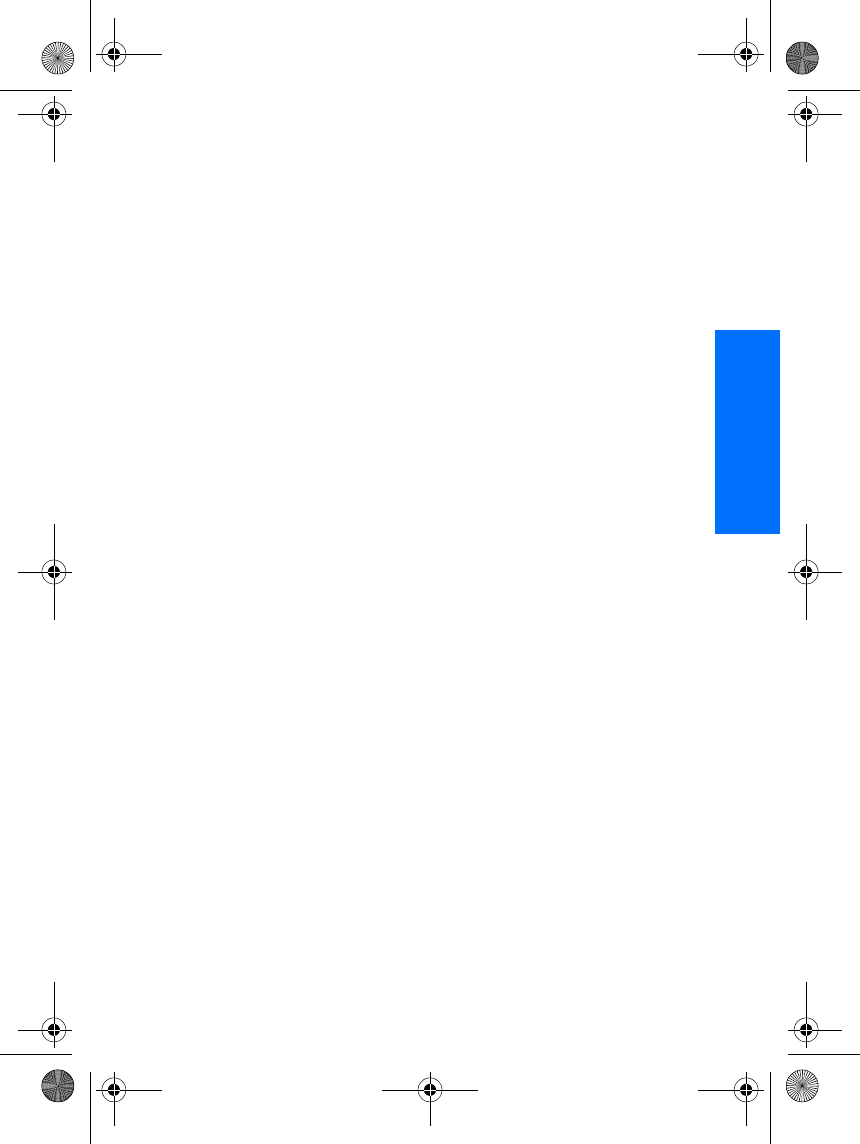
IMPORTANT SAFETY INFORMATION
81
English
with all reported SAR levels
evaluated as in compliance with the
FCC RF exposure guidelines. SAR
information on this model phone is
on file with the FCC and can be
found under the Display Grant
section of http://www.fcc.gov/oet/
fccid after searching on FCC ID
QTLRH-6.
For body worn operation, this phone
has been tested and meets the FCC RF
exposure guidelines for use with an
accessory that contains no metal and
that positions the handset a minimum
of 5/8 inch (1.5 cm) from the body. Use
of other accessories may not ensure
compliance with FCC RF exposure
guidelines. If you do not use a body
worn accessory, and are not holding
the phone at the ear, position the
handset a minimum of 5/8 inch (1.5
cm) from your body when the phone is
switched on.
*In the United States and Canada, the
SAR limit for mobile phones used by
the public is 1.6 watts/kilogram (W/
kg) averaged over one gram of tissue.
The standard incorporates a substantial
margin of safety to give additional
protection for the public and to account
for any variations in measurements.
SAR values may vary depending on
national reporting equirements and the
network band. For SAR information in
other regions please look under
product information at
www.nokia.com. For body worn
operation, this phone has been tested
and meets the FCC RF exposure
guidelines when used with the Nokia
accessories supplied or designated for
this product. Use of other accessories
may not ensure compliance with FCC
RF exposure guidelines.
3108_Dufu_fcc_1.1.fm Page 81 Friday, October 24, 2003 2:20 AM

IMPORTANT SAFETY INFORMATION
82
APPENDIX
■A message from the CTIA
(Cellular Telecommunications and Internet
Association)
© 2001 Cellular
Telecommunications & Internet
Association.
All Rights Reserved.
1250 Connecticut Avenue, NW
Suite 800, Washington, DC 20036.
Phone: (202) 785-0081
3108_Dufu_fcc_1.1.fm Page 82 Friday, October 24, 2003 2:20 AM

IMPORTANT SAFETY INFORMATION
83
English
Safety is the most important call
you will ever make.
A Guide to Safe and Responsible
Wireless Phone Use
Tens of millions of people in the
u.s. today take advantage of the
unique combination of
convenience, safety and value
delivered by the wireless telephone.
Quite simply, the wireless phone
gives people the powerful ability to
communicate by voice--almost
anywhere, anytime--with the boss,
with a client, with the kids, with
emergency personnel or even with
the police. each year, americans
make billions of calls from their
wireless phones, and the numbers
are rapidly growing.
But an important responsibility
accompanies those benefits, one
that every wireless phone user must
uphold. When driving a car, driving
is your first responsibility. A
wireless phone can be an invaluable
tool, but good judgment must be
exercised at all times while driving
a motor vehicle--whether on the
phone or not.
The basic lessons are ones we all
learned as teenagers. Driving
requires alertness, caution and
courtesy. It requires a heavy dose of
basic common sense---keep your
head up, keep your eyes on the
road, check your mirrors frequently
and watch out for other drivers. It
requires obeying all traffic signs
and signals and staying within the
speed limit. It means using seatbelts
and requiring other passengers to
do the same.
But with wireless phone use,
driving safely means a little more.
This brochure is a call to wireless
phone users everywhere to make
safety their first priority when
behind the wheel of a car. Wireless
telecommunications is keeping us
in touch, simplifying our lives,
protecting us in emergencies and
providing opportunities to help
others in need.
When it comes to the use of
wireless phones, safety is your most
important call.
Wireless Phone “Safety Tips”
Below are safety tips to follow
while driving and using a wireless
phone which should be easy to
remember.
1. Get to know your wireless
phone and its features such as
speed dial and redial. Carefully
read your instruction manual
and learn to take advantage of
valuable features most phones
offer, including automatic
redial and memory. Also, work
to memorize the phone keypad
so you can use the speed dial
function without taking your
attention off the road.
2. When available, use a hands
free device. A number of hands
3108_Dufu_fcc_1.1.fm Page 83 Friday, October 24, 2003 2:20 AM

IMPORTANT SAFETY INFORMATION
84
free wireless phone accessories
are readily available today.
Whether you choose an
installed mounted device for
your wireless phone or a
speaker phone accessory, take
advantage of these devices if
available to you.
3. Position your wireless phone
within easy reach. Make sure
you place your wireless phone
within easy reach and where
you can grab it without
removing your eyes from the
road. If you get an incoming
call at an inconvenient time, if
possible, let your voice mail
answer it for you.
4. Suspend conversations during
hazardous driving conditions or
situations. Let the person you
are speaking with know you are
driving; if necessary, suspend
the call in heavy traffic or
hazardous weather conditions.
Rain, sleet, snow and ice can be
hazardous, but so is heavy
traffic. As a driver, your first
responsibility is to pay attention
to the road.
5. Do not take notes or look up
phone numbers while driving.
If you are reading an address
book or business card, or
writing a “to do” list while
driving a car, you are not
watching where you are going.
It’s common sense. Don’t get
caught in a dangerous situation
because you are reading or
writing and not paying attention
to the road or nearby vehicles.
6. Dial sensibly and assess the
traffic; if possible, place calls
when you are not moving or
before pulling into traffic. Try
to plan your calls before you
begin your trip or attempt to
coincide your calls with times
you may be stopped at a stop
sign, red light or otherwise
stationary. But if you need to
dial while driving, follow this
simple tip--dial only a few
numbers, check the road and
your mirrors, then continue.
7. Do not engage in stressful or
emotional conversations that
may be distracting. Stressful or
emotional conversations and
driving do not mix--they are
distracting and even dangerous
when you are behind the wheel
of a car. Make people you are
talking with aware you are
driving and if necessary,
suspend conversations which
have the potential to divert your
attention from the road.
8. Use your wireless phone to call
for help. Your wireless phone is
one of the greatest tools you can
own to protect yourself and
your family in dangerous
situations--with your phone at
your side, help is only three
3108_Dufu_fcc_1.1.fm Page 84 Friday, October 24, 2003 2:20 AM

IMPORTANT SAFETY INFORMATION
85
English
numbers away. Dial 9-1-1 or
other local emergency number
in the case of fire, traffic
accident, road hazard or
medical emergency.
Remember, it is a free call on
your wireless phone!
9. Use your wireless phone to help
others in emergencies. Your
wireless phone provides you a
perfect opportunity to be a
“Good Samaritan” in your
community. If you see an auto
accident, crime in progress or
other serious emergency where
lives are in danger, call 9-1-1 or
other local emergency number,
as you would want others to do
for you.
10. Call roadside assistance or a
special wireless non-
emergency assistance number
when necessary. Certain
situations you encounter while
driving may require attention,
but are not urgent enough to
merit a call for emergency
services. But you still can use
your wireless phone to lend a
hand. If you see a broken-down
vehicle posing no serious
hazard, a broken traffic signal, a
minor traffic accident where no
one appears injured or a vehicle
you know to be stolen, call
roadside assistance or other
special non-emergency
wireless number.
Careless, distracted individuals and
people driving irresponsibly
represent a hazard to everyone on
the road. Since 1984, the Cellular
Telecommunications Industry
Association and the wireless
industry have conducted
educational outreach to inform
wireless phone users of their
responsibilities as safe drivers and
good citizens. As we approach a
new century, more and more of us
will take advantage of the benefits
of wireless telephones. And, as we
take to the roads, we all have a
responsibility to drive safely.
The wireless industry reminds you
to use your phone safely when
driving.
For more information, please call 1-
888-901-SAFE.
For updates: http://www.wow-
com.com/consumer/issues/driving/
articles.cfm?ID=85
© 2001 Cellular
Telecommunications & Internet
Association.
All Rights Reserved.1250
Connecticut Avenue, NW Suite
800, Washington, DC 20036.
Phone: (202) 785-0081
3108_Dufu_fcc_1.1.fm Page 85 Friday, October 24, 2003 2:20 AM

IMPORTANT SAFETY INFORMATION
86
■A message from the U.S. Food and Drug
Administration
July 18, 2001 For updates: http://www.fda.gov/cdrh/phones
3108_Dufu_fcc_1.1.fm Page 86 Friday, October 24, 2003 2:20 AM
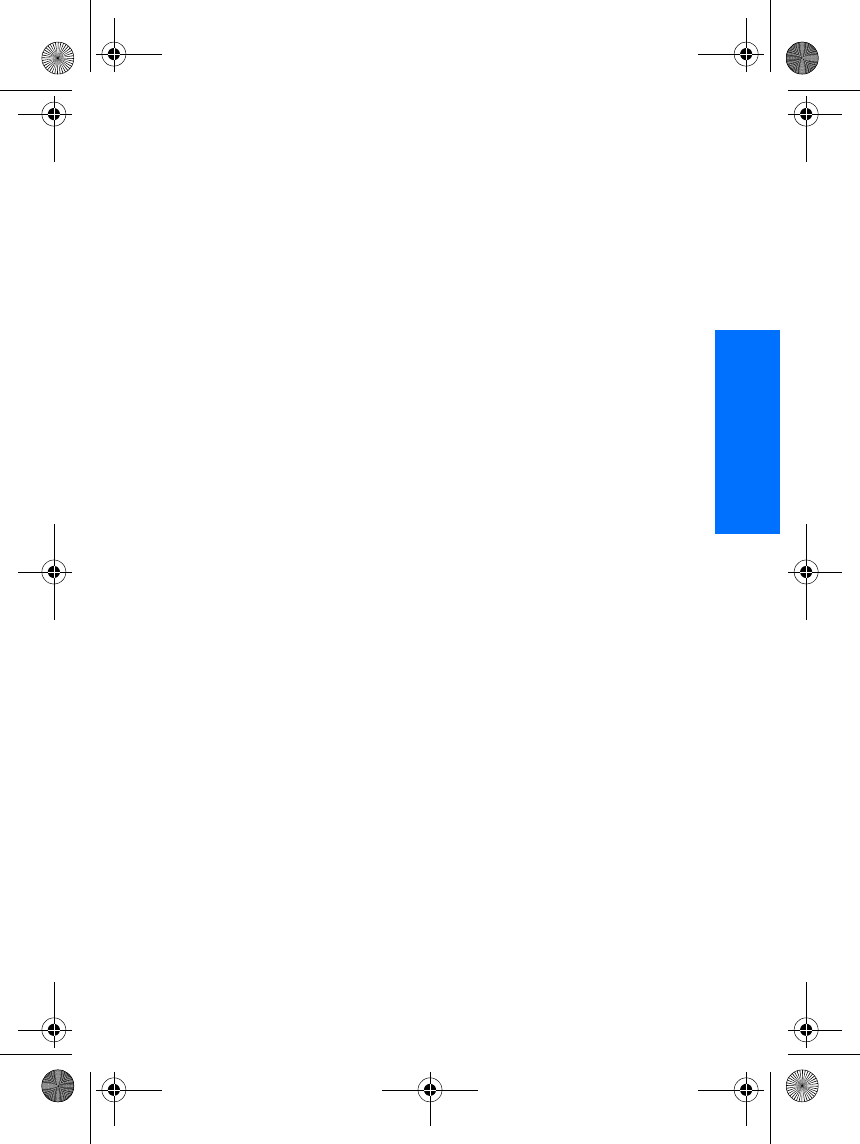
IMPORTANT SAFETY INFORMATION
87
English
1. Do wireless phones pose a
health hazard?
The available scientific evidence
does not show that any health
problems are associated with using
wireless phones. There is no proof,
however, that wireless phones are
absolutely safe. Wireless phones
emit low levels of radiofrequency
energy (RF) in the microwave
range while being used. They also
emit very low levels of RF when in
the stand-by mode. Whereas high
levels of RF can produce health
effects (by heating tissue), exposure
to low level RF that does not
produce heating effects causes no
known adverse health effects.
Many studies of low level RF
exposures have not found any
biological effects. Some studies
have suggested that some biological
effects may occur, but such findings
have not been confirmed by
additional research. In some cases,
other researchers have had
difficulty in reproducing those
studies, or in determining the
reasons for inconsistent results.
2. What is FDA's role concerning
the safety of wireless phones?
Under the law, FDA does not
review the safety of radiation-
emitting consumer products such as
wireless phones before they can be
sold, as it does with new drugs or
medical devices. However, the
agency has authority to take action
if wireless phones are shown to
emit radiofrequency energy (RF) at
a level that is hazardous to the user.
In such a case, FDA could require
the manufacturers of wireless
phones to notify users of the health
hazard and to repair, replace or
recall the phones so that the hazard
no longer exists.
Although the existing scientific
data do not justify FDA regulatory
actions, FDA has urged the wireless
phone industry to take a number of
steps, including the following:
• Support needed research into
possible biological effects of RF of
the type emitted by wireless
phones;
• Design wireless phones in a way
that minimizes any RF exposure to
the user that is not necessary for
device function; and
• Cooperate in providing users of
wireless phones with the best
possible information on possible
effects of wireless phone use on
human health.
FDA belongs to an interagency
working group of the federal
agencies that have responsibility for
different aspects of RF safety to
ensure coordinated efforts at the
federal level. The following
agencies belong to this working
group:
• National Institute for
Occupational Safety and Health
3108_Dufu_fcc_1.1.fm Page 87 Friday, October 24, 2003 2:20 AM

IMPORTANT SAFETY INFORMATION
88
• Environmental Protection Agency
• Federal Communications
Commission
• Occupational Safety and Health
Administration
• National Telecommunications and
Information Administration
The National Institutes of Health
participates in some interagency
working group activities, as well.
FDA shares regulatory
responsibilities for wireless phones
with the Federal Communications
Commission (FCC). All phones
that are sold in the United States
must comply with FCC safety
guidelines that limit RF exposure.
FCC relies on FDA and other health
agencies for safety questions about
wireless phones.
FCC also regulates the base stations
that the wireless phone networks
rely upon. While these base stations
operate at higher power than do the
wireless phones themselves, the RF
exposures that people get from
these base stations are typically
thousands of times lower than those
they can get from wireless phones.
Base stations are thus not the
subject of the safety questions
discussed in this document.
3. What kinds of phones are the
subject of this update?
The term wireless phone refers here
to hand-held wireless phones with
built-in antennas, often called cell
mobile or PCS phones. These types
of wireless phones can expose the
user to measurable radiofrequency
energy (RF) because of the short
distance between the phone and the
user’s head. These RF exposures
are limited by Federal
Communications Commission
safety guidelines that were
developed with the advice of FDA
and other federal health and safety
agencies. When the phone is
located at greater distances from the
user, the exposure to RF is
drastically lower because a person's
RF exposure decreases rapidly with
increasing distance from the source.
The so-called cordless phones;
which have a base unit connected to
the telephone wiring in a house,
typically operate at far lower power
levels, and thus produce RF
exposures far below the FCC safety
limits.
4. What are the results of the
research done already?
The research done thus far has
produced conflicting results, and
many studies have suffered from
flaws in their research methods.
Animal experiments investigating
the effects of radiofrequency
energy (RF) exposures
characteristic of wireless phones
have yielded conflicting results that
often cannot be repeated in other
laboratories. A few animal studies,
3108_Dufu_fcc_1.1.fm Page 88 Friday, October 24, 2003 2:20 AM

IMPORTANT SAFETY INFORMATION
89
English
however, have suggested that low
levels of RF could accelerate the
development of cancer in
laboratory animals. However, many
of the studies that showed increased
tumor development used animals
that had been genetically
engineered or treated with cancer-
causing chemicals so as to be pre-
disposed to develop cancer in the
absence of RF exposure. Other
studies exposed the animals to RF
for up to 22 hours per day. These
conditions are not similar to the
conditions under which people use
wireless phones, so we don’t know
with certainty what the results of
such studies mean for human
health.
Three large epidemiology studies
have been published since
December 2000. Between them, the
studies investigated any possible
association between the use of
wireless phones and primary brain
cancer, glioma, meningioma, or
acoustic neuroma, tumors of the
brain or salivary gland, leukemia,
or other cancers. None of the
studies demonstrated the existence
of any harmful health effects from
wireless phone RF exposures.
However, none of the studies can
answer questions about long-term
exposures, since the average period
of phone use in these studies was
around three years.
5. What research is needed to
decide whether RF exposure
from wireless phones poses a
health risk?
A combination of laboratory studies
and epidemiological studies of
people actually using wireless
phones would provide some of the
data that are needed. Lifetime
animal exposure studies could be
completed in a few years. However,
very large numbers of animals
would be needed to provide reliable
proof of a cancer promoting effect
if one exists. Epidemiological
studies can provide data that is
directly applicable to human
populations, but 10 or more years
follow-up may be needed to
provide answers about some health
effects, such as cancer. This is
because the interval between the
time of exposure to a cancer-
causing agent and the time tumors
develop - if they do - may be many,
many years. The interpretation of
epidemiological studies is
hampered by difficulties in
measuring actual RF exposure
during day-to-day use of wireless
phones. Many factors affect this
measurement, such as the angle at
which the phone is held, or which
model of phone is used.
6. What is FDA doing to find out
more about the possible health
effects of wireless phone RF?
3108_Dufu_fcc_1.1.fm Page 89 Friday, October 24, 2003 2:20 AM

IMPORTANT SAFETY INFORMATION
90
FDA is working with the U.S.
National Toxicology Program and
with groups of investigators around
the world to ensure that high
priority animal studies are
conducted to address important
questions about the effects of
exposure to radiofrequency energy
(RF). FDA has been a leading
participant in the World Health
Organization International
Electromagnetic Fields (EMF)
Project since its inception in 1996.
An influential result of this work
has been the development of a
detailed agenda of research needs
that has driven the establishment of
new research programs around the
world. The Project has also helped
develop a series of public
information documents on EMF
issues.
FDA and the Cellular
Telecommunications & Internet
Association (CTIA) have a formal
Cooperative Research and
Development Agreement
(CRADA) to do research on
wireless phone safety. FDA
provides the scientific oversight,
obtaining input from experts in
government, industry, and
academic organizations. CTIA-
funded research is conducted
through contracts to independent
investigators. The initial research
will include both laboratory studies
and studies of wireless phone users.
The CRADA will also include a
broad assessment of additional
research needs in the context of the
latest research developments
around the world.
7. How can I find out how much
radiofrequency energy exposure
I can get by using my wireless
phone?
All phones sold in the United States
must comply with Federal
Communications Commission
(FCC) guidelines that limit
radiofrequency energy (RF)
exposures. FCC established these
guidelines in consultation with
FDA and the other federal health
and safety agencies. The FCC limit
for RF exposure from wireless
telephones is set at a Specific
Absorption Rate (SAR) of 1.6 watts
per kilogram (1.6 W/kg). The FCC
limit is consistent with the safety
standards developed by the Institute
of Electrical and Electronic
Engineering (IEEE) and the
National Council on Radiation
Protection and Measurement. The
exposure limit takes into
consideration the body’s ability to
remove heat from the tissues that
absorb energy from the wireless
phone and is set well below levels
known to have effects.
Manufacturers of wireless phones
must report the RF exposure level
for each model of phone to the
FCC. The FCC website (http://
3108_Dufu_fcc_1.1.fm Page 90 Friday, October 24, 2003 2:20 AM

IMPORTANT SAFETY INFORMATION
91
English
www.fcc.gov/oet/rfsafety) gives
directions for locating the FCC
identification number on your
phone so you can find your phone’s
RF exposure level in the online
listing.
8. What has FDA done to
measure the radiofrequency
energy coming from wireless
phones?
The Institute of Electrical and
Electronic Engineers (IEEE) is
developing a technical standard for
measuring the radiofrequency
energy (RF) exposure from wireless
phones and other wireless handsets
with the participation and
leadership of FDA scientists and
engineers. The standard,
Recommended Practice for
Determining the Spatial-Peak
Specific Absorption Rate (SAR) in
the Human Body Due to Wireless
Communications Devices:
Experimental Techniques, sets
forth the first consistent test
methodology for measuring the rate
at which RF is deposited in the
heads of wireless phone users. The
test method uses a tissue-simulating
model of the human head.
Standardized SAR test
methodology is expected to greatly
improve the consistency of
measurements made at different
laboratories on the same phone.
SAR is the measurement of the
amount of energy absorbed in
tissue, either by the whole body or a
small part of the body. It is
measured in watts/kg (or
milliwatts/g) of matter. This
measurement is used to determine
whether a wireless phone complies
with safety guidelines.
9. What steps can I take to reduce
my exposure to radiofrequency
energy from my wireless phone?
If there is a risk from these
products--and at this point we do
not know that there is--it is
probably very small. But if you are
concerned about avoiding even
potential risks, you can take a few
simple steps to minimize your
exposure to radiofrequency energy
(RF). Since time is a key factor in
how much exposure a person
receives, reducing the amount of
time spent using a wireless phone
will reduce RF exposure.
If you must conduct extended
conversations by wireless phone
every day, you could place more
distance between your body and the
source of the RF, since the exposure
level drops off dramatically with
distance. For example, you could
use a headset and carry the wireless
phone away from your body or use
a wireless phone connected to a
remote antenna. Again, the
scientific data do not demonstrate
that wireless phones are harmful.
But if you are concerned about the
RF exposure from these products,
3108_Dufu_fcc_1.1.fm Page 91 Friday, October 24, 2003 2:20 AM

IMPORTANT SAFETY INFORMATION
92
you can use measures like those
described above to reduce your RF
exposure from wireless phone use.
10. What about children using
wireless phones?
The scientific evidence does not
show a danger to users of wireless
phones, including children and
teenagers. If you want to take steps
to lower exposure to
radiofrequency energy (RF), the
measures described above would
apply to children and teenagers
using wireless phones. Reducing
the time of wireless phone use and
increasing the distance between the
user and the RF source will reduce
RF exposure.Some groups
sponsored by other national
governments have advised that
children be discouraged from using
wireless phones at all. For example,
the government in the United
Kingdom distributed leaflets
containing such a recommendation
in December 2000. They noted that
no evidence exists that using a
wireless phone causes brain tumors
or other ill effects. Their
recommendation to limit wireless
phone use by children was strictly
precautionary; it was not based on
scientific evidence that any health
hazard exists.
11. What about wireless phone
interference with medical
equipment?
Radiofrequency energy (RF) from
wireless phones can interact with
some electronic devices. For this
reason, FDA helped develop a
detailed test method to measure
electromagnetic interference (EMI)
of implanted cardiac pacemakers
and defibrillators from wireless
telephones. This test method is now
part of a standard sponsored by the
Association for the Advancement
of Medical instrumentation
(AAMI). The final draft, a joint
effort by FDA, medical device
manufacturers, and many other
groups, was completed in late 2000.
This standard will allow
manufacturers to ensure that
cardiac pacemakers and
defibrillators are safe from wireless
phone EMI. FDA has tested hearing
aids for interference from handheld
wireless phones and helped develop
a voluntary standard sponsored by
the Institute of Electrical and
Electronic Engineers (IEEE). This
standard specifies test methods and
performance requirements for
hearing aids and wireless phones so
that no interference occurs when a
person uses a compatible phone and
a accompanied hearing aid at the
same time. This standard was
approved by the IEEE in 2000.
FDA continues to monitor the use
of wireless phones for possible
interactions with other medical
devices. Should harmful
3108_Dufu_fcc_1.1.fm Page 92 Friday, October 24, 2003 2:20 AM

IMPORTANT SAFETY INFORMATION
93
English
interference be found to occur,
FDA will conduct testing to assess
the interference and work to resolve
the problem.
12. Where can I find additional
information?
For additional information, please
refer to the following resources:
FDA web page on wireless
phones
http://www.fda.gov/cdrh/
phones/index.html
Federal Communications
Commission (FCC) RF Safety
Program
http://www.fcc.gov/oet/rfsafety
International Commission on
Non-Ionizing Radiation
Protection
http://www.icnirp.de
World Health Organization
(WHO) International EMF
Project
http://www.who.int/emf
National Radiological
Protection Board (UK)
http://www.nrpb.org.uk/
July 18, 2001 For updates: http://
www.fda.gov/cdrh/phones
3108_Dufu_fcc_1.1.fm Page 93 Friday, October 24, 2003 2:20 AM